Microsoft RM-209 GSM 900/1800/1900 Cellular Telephone W/BT User Manual RM 209 en 1 FCC
Microsoft Mobile Oy GSM 900/1800/1900 Cellular Telephone W/BT RM 209 en 1 FCC
Manual

DRAFT
Nokia 7373 User Guide
925XXXX
Issue 1
RM-209_en_1_FCC.fm Page 1 Thursday, September 7, 2006 12:18 PM

DRAFT
DECLARATION OF CONFORMITY
Hereby, NOKIA CORPORATION declares that this RM-209 product is in compliance with the
essential requirements and other relevant provisions of Directive 1999/5/EC
A copy of the Declaration of Conformity can be found from
http://www.nokia.com/phones/declaration_of_conformity/.
The crossed-out wheeled bin means that within the European Union the product
must be taken to separate collection at the product end-of life. This applies to
your device but also to any enhancements marked with this symbol. Do not
dispose of these products as unsorted municipal waste. For more information, see
product Eco-Declaration or country specific information at www.nokia.com.
Copyright © 2006 Nokia. All rights reserved.
Reproduction, transfer, distribution or storage of part or all of the contents in this document
in any form without the prior written permission of Nokia is prohibited.
Nokia, Nokia Connecting People, Xpress-on, XpressPrint, and Pop-Port are trademarks or
registered trademarks of Nokia Corporation. Other product and company names mentioned
herein may be trademarks or tradenames of their respective owners.
Nokia tune is a sound mark of Nokia Corporation.
US Patent No 5818437 and other pending patents. T9 text input software Copyright (C)
1997-2006. Tegic Communications, Inc. All rights reserved.
Includes RSA BSAFE cryptographic or security protocol software from RSA Security.
Java is a trademark of Sun Microsystems, Inc.
This product is licensed under the MPEG-4 Visual Patent Portfolio License (i) for personal and
noncommercial use in connection with information which has been encoded in compliance
with the MPEG-4 Visual Standard by a consumer engaged in a personal and noncommercial
activity and (ii) for use in connection with MPEG-4 video provided by a licensed video
provider. No license is granted or shall be implied for any other use. Additional information
including that relating to promotional, internal and commercial uses may be obtained from
MPEG LA, LLC. See <http://www.mpegla.com>.
Nokia operates a policy of continuous development. Nokia reserves the right to make
changes and improvements to any of the products described in this document without prior
notice.
0434
RM-209_en_1_FCC.fm Page 2 Thursday, September 7, 2006 12:18 PM

DRAFT
This device complies with Directive 2002/95/EC on the restriction of the use of certain
hazardous substances in electrical and electronic equipment.
Under no circumstances shall Nokia be responsible for any loss of data or income or any
special, incidental, consequential or indirect damages howsoever caused.
The contents of this document are provided "as is". Except as required by applicable law, no
warranties of any kind, either express or implied, including, but not limited to, the implied
warranties of merchantability and fitness for a particular purpose, are made in relation to the
accuracy, reliability or contents of this document. Nokia reserves the right to revise this
document or withdraw it at any time without prior notice.
The availability of particular products may vary by region. Please check with the Nokia dealer
nearest to you.
This device may contain commodities, technology or software subject to export laws and
regulations from the US and other countries. Diversion contrary to law is prohibited.
FCC/INDUSTRY CANADA NOTICE
Your device may cause TV or radio interference (for example, when using a telephone in close
proximity to receiving equipment). The FCC or Industry Canada can require you to stop using
your telephone if such interference cannot be eliminated. If you require assistance, contact
your local service facility. This device complies with part 15 of the FCC rules. Operation is
subject to the following two conditions: (1) This device may not cause harmful interference,
and (2) this device must accept any interference received, including interference that may
cause undesired operation. Any changes or modifications not expressly approved by Nokia
could void the user's authority to operate this equipment.
925XXXX/Issue 1
RM-209_en_1_FCC.fm Page 3 Thursday, September 7, 2006 12:18 PM

4
DRAFT
Contents
For your safety.......................... 6
General information................. 9
Access codes............................................ 9
Configuration settings service ........ 10
Download content .............................. 10
Nokia support....................................... 10
1. Get started ......................... 11
Install SIM card and battery............ 11
Insert a microSD card ........................ 12
Charge the battery.............................. 13
Open and close the phone................ 13
Switch the phone on and off........... 14
Antenna ................................................. 14
Phone strap........................................... 15
2. Your phone......................... 16
Keys and parts...................................... 16
Standby mode...................................... 17
Flight mode........................................... 19
Keypad lock (keyguard) ..................... 19
Functions without a SIM card......... 20
3. Call functions..................... 20
Make a call ........................................... 20
Answer or reject a call....................... 21
Options during a call.......................... 22
4. Write text........................... 22
Traditional text input......................... 23
Predictive text input .......................... 23
5. Navigate the menus .......... 24
6. Messaging .......................... 25
Text message........................................ 25
Multimedia message.......................... 26
Postcards ............................................... 28
Flash messages .................................... 29
Nokia Xpress audio messaging........ 29
Memory full.......................................... 30
Folders.................................................... 30
E-mail application .............................. 30
Instant messaging............................... 33
Voice messages.................................... 37
Info messages ...................................... 37
Service commands.............................. 37
Delete messages.................................. 37
SIM messages....................................... 38
Message settings................................. 38
7. Contacts.............................. 41
Search for a contact .......................... 41
Save names and phone numbers.... 41
Save details........................................... 41
Copy or move contacts...................... 42
Edit contact details ............................ 42
Synchronize all .................................... 42
Delete contacts.................................... 42
Business cards...................................... 43
Settings.................................................. 43
Groups.................................................... 43
Speed dials............................................ 44
Info, service, and my numbers ........ 44
8. Call log................................ 44
Location information ......................... 45
9. Settings............................... 45
Profiles ................................................... 45
Themes ................................................... 46
Tones....................................................... 46
Display.................................................... 46
Time and date ...................................... 47
My shortcuts ........................................ 47
Connectivity ......................................... 49
Call .......................................................... 53
Phone...................................................... 54
RM-209_en_1_FCC.fm Page 4 Thursday, September 7, 2006 12:18 PM

5
DRAFT
Enhancements...................................... 55
Configuration........................................ 55
Security .................................................. 56
Restore factory settings..................... 57
Phone software updates.................... 57
10. Operator menu ................ 58
11. Gallery.............................. 59
Print images.......................................... 59
Memory card......................................... 59
12. Media ............................... 61
Camera and video................................ 61
Media player ......................................... 62
Music player.......................................... 63
Radio ....................................................... 64
Voice recorder....................................... 66
Equalizer................................................. 66
Stereo widening................................... 67
13. Organizer.......................... 67
Alarm clock............................................ 67
Calendar................................................. 68
To-do list................................................ 68
Notes....................................................... 69
Calculator .............................................. 69
Countdown timer ................................ 69
Stopwatch ............................................. 69
14. Applications..................... 70
Launch a game..................................... 70
Launch an application........................ 71
Application options............................. 71
Download an application .................. 71
15. Web................................... 72
Set up browsing................................... 72
Connect to a service........................... 72
Browse pages........................................ 73
Bookmarks ............................................. 73
Appearance settings ........................... 74
Security settings .................................. 75
Download settings .............................. 75
Service inbox ........................................ 75
Cache memory...................................... 76
Browser security .................................. 76
16. SIM services ..................... 78
17. PC connectivity................ 79
Nokia PC Suite...................................... 79
Packet data, HSCSD, and CSD.......... 79
Bluetooth............................................... 79
Data communication applications . 80
18. Battery information......... 80
Charging and discharging ................. 80
Nokia battery authentication .......... 81
19. Technical Information ..... 83
Care and maintenance ........... 84
Additional safety information 85
APPENDIX ............................... 89
A message from the CTIA........... 89
Message from FDA ....................... 91
RM-209_en_1_FCC.fm Page 5 Thursday, September 7, 2006 12:18 PM
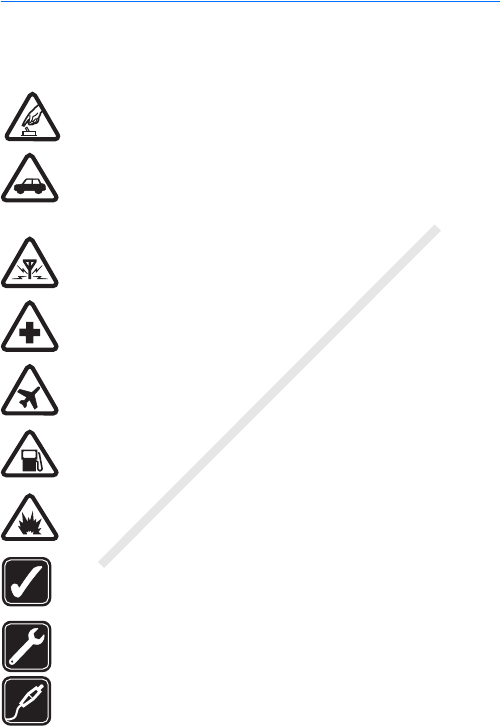
For your safety
6
DRAFT
For your safety
Read these simple guidelines. Not following them may be dangerous or illegal.
Read the complete user guide for further information.
SWITCH ON SAFELY
Do not switch the phone on when wireless phone use is prohibited or
when it may cause interference or danger.
ROAD SAFETY COMES FIRST
Obey all local laws. Always keep your hands free to operate the
vehicle while driving. Your first consideration while driving should be
road safety.
INTERFERENCE
All wireless phones may be susceptible to interference, which could
affect performance.
SWITCH OFF IN HOSPITALS
Follow any restrictions. Switch the phone off near medical
equipment.
SWITCH OFF IN AIRCRAFT
Follow any restrictions. Wireless devices can cause interference in
aircraft.
SWITCH OFF WHEN REFUELLING
Do not use the phone at a refuelling point. Do not use near fuel or
chemicals.
SWITCH OFF NEAR BLASTING
Follow any restrictions. Do not use the phone where blasting is in
progress.
USE SENSIBLY
Use only in the normal position as explained in the product
documentation. Do not touch the antenna unnecessarily.
QUALIFIED SERVICE
Only qualified personnel may install or repair this product.
ENHANCEMENTS AND BATTERIES
Use only approved enhancements and batteries. Do not connect
incompatible products.
RM-209_en_1_FCC.fm Page 6 Thursday, September 7, 2006 12:18 PM
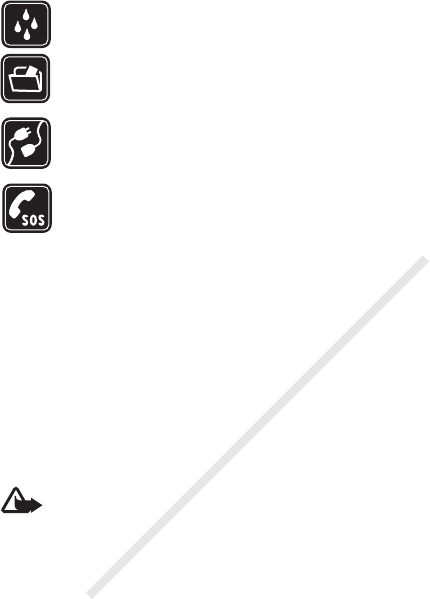
For your safety
7
DRAFT
WATER-RESISTANCE
Your phone is not water-resistant. Keep it dry.
BACK-UP COPIES
Remember to make back-up copies or keep a written record of all
important information stored in your phone.
CONNECTING TO OTHER DEVICES
When connecting to any other device, read its user guide for detailed
safety instructions. Do not connect incompatible products.
EMERGENCY CALLS
Ensure the phone is switched on and in service. Press the end key as
many times as needed to clear the display and return to the start
screen. Enter the emergency number, then press the call key. Give
your location. Do not end the call until given permission to do so.
■About your device
The wireless device described in this guide is approved for use on the EGSM 900
and GSM 1800 and 1900 networks. Contact your service provider for more
information about networks.
When using the features in this device, obey all laws and respect the privacy and
legitimate rights of others.
When taking and using images or video clips, obey all laws and respect local
customs as well as privacy and legitimate rights of others including copyrights.
Warning: To use any features in this device, other than the alarm clock,
the device must be switched on. Do not switch the device on when
wireless device use may cause interference or danger.
■Network services
To use the phone you must have service from a wireless service provider. Many of
the features in this device depend on features in the wireless network to
function. These network services may not be available on all networks or you may
have to make specific arrangements with your service provider before you can
utilize network services. Your service provider may need to give you additional
instructions for their use and explain what charges will apply. Some networks
may have limitations that affect how you can use network services. For instance,
some networks may not support all language-dependent characters and services.
Your service provider may have requested that certain features be disabled or not
activated in your device. If so, they will not appear on your device menu. Your
RM-209_en_1_FCC.fm Page 7 Thursday, September 7, 2006 12:18 PM

For your safety
8
DRAFT
device may also have been specially configured for your network provider. This
configuration may include changes in menu names, menu order and icons.
Contact your service provider for more information.
This device supports WAP 2.0 protocols (HTTP and SSL) that run on TCP/IP
protocols. Some features of this device, such as multimedia messaging service
(MMS), browsing, e-mail application, instant messaging, presence enhanced
contacts, remote synchronization, and content downloading using the browser or
MMS, require network support for these technologies.
■Shared memory
The following features in this device may share memory: gallery, contacts, text
messages, multimedia messages, and instant messages, e-mail, calendar, to-do
notes, JavaTM games and applications, and note application. Use of one or more of
these features may reduce the memory available for the remaining features
sharing memory. For example, saving many Java applications may use all of the
available memory. Your device may display a message that the memory is full
when you try to use a shared memory feature. In this case, delete some of the
information or entries stored in the shared memory features before continuing.
Some of the features, such as text messages, may have a certain amount of
memory specially allotted to them in addition to the memory shared with other
features.
■Enhancements
A few practical rules about accessories and enhancements:
• Keep all accessories and enhancements out of the reach of small children.
• When you disconnect the power cord of any accessory or enhancement, grasp
and pull the plug, not the cord.
• Check regularly that enhancements installed in a vehicle are mounted and
are operating properly.
• Installation of any complex car enhancements must be made by qualified
personnel only.
RM-209_en_1_FCC.fm Page 8 Thursday, September 7, 2006 12:18 PM

General information
9
DRAFT
General information
■Access codes
Security code
The security code (5 to 10 digits) helps to protect your phone against
unauthorized use. The preset code is 12345. To change the code, and to
set the phone to request the code, see “Security,” p. 56.
PIN codes
The personal identification number (PIN) code and the universal
personal identification number (UPIN) code (4 to 8 digits) help to
protect your SIM card against unauthorized use. See “Security,” p. 56.
The PIN2 code (4 to 8 digits) may be supplied with the SIM card and is
required for some functions.
The module PIN is required to access the information in the security
module. See “Security module,” p. 77.
The signing PIN is required for the digital signature. See “Digital
signature,” p. 78.
PUK codes
The personal unblocking key (PUK) code and the universal personal
unblocking key (UPUK) code (8 digits) is required to change a blocked
PIN code and UPIN code, respectively. The PUK2 code (8 digits) is
required to change a blocked PIN2 code. If the codes are not supplied
with the SIM card, contact your local service provider for the codes.
Barring password
The barring password (4 digits) is required when using the Call barring
service. See “Security,” p. 56.
RM-209_en_1_FCC.fm Page 9 Thursday, September 7, 2006 12:18 PM

General information
10
DRAFT
■Configuration settings service
To use some of the network services, such as mobile Internet services,
MMS, Nokia Xpress audio messaging, or remote Internet server
synchronization, your phone needs the correct configuration settings.
For more information on availability, contact your network operator,
service provider, nearest authorized Nokia dealer, or visit the support
area on the Nokia Web site, www.nokia.com/support.
When you have received the settings as a configuration message, and
the settings are not automatically saved and activated, Configuration
settings received is displayed.
To save the settings, select Show > Save. If required, enter the PIN code
supplied by the service provider.
To discard the received settings, select Exit or Show > Discard.
■Download content
You may be able to download new content (for example, themes) to the
phone (network service). You may also be able to download updates of
phone software (network service). See “Phone,” p. 54, Phone updates.
For the availability of different services, pricing, and tariffs, contact your
service provider.
Important: Use only services that you trust and that offer adequate
security and protection against harmful software.
■Nokia support
Check www.nokia.com/support or your local Nokia Web site for the
latest version of this guide, additional information, downloads, and
services related to your Nokia product.
On the Web site, you can get information on the use of Nokia products
and services. If you need to contact customer service, check the list of
local Nokia Care contact centers at www.nokia.com/customerservice.
For maintenance services, check your nearest Nokia service center at
www.nokia.com/repair.
RM-209_en_1_FCC.fm Page 10 Thursday, September 7, 2006 12:18 PM

Get started
11
DRAFT
1. Get started
■Install SIM card and battery
Always switch the device off and disconnect the charger before removing the
battery.
Keep all SIM cards and memory cards out of the reach of small children.
For availability and information on using SIM card services, contact your SIM
card vendor. This may be the service provider, network operator, or other vendor.
This device is intended for use with BL-4B battery. Always use original
Nokia batteries. See “Nokia battery authentication,” p. 81.
The SIM card and its contacts can easily be damaged by scratches or
bending, so be careful when handling, inserting, or removing the card.
To remove the back cover of the phone, press
and slide the cover (1).
Remove the battery as
shown (2). Open (3)
the SIM card holder.
Insert the SIM card
properly into the
holder (4). Close the
SIM card holder (5),
and slightly press the
holder to lock it (6).
RM-209_en_1_FCC.fm Page 11 Thursday, September 7, 2006 12:18 PM
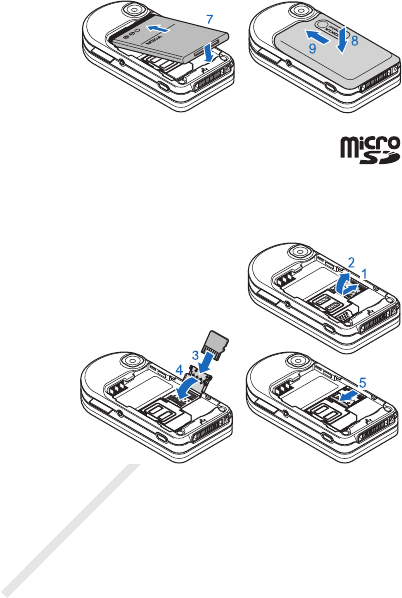
Get started
12
DRAFT
Replace the battery
(7). Observe the
battery contacts. Slide
the back cover into its
place (8, 9).
■Insert a microSD card
Keep all microSD memory cards out of the reach of small children.
Switch the phone off, and remove the back cover and the battery of the
phone.
Slide the memory card
holder to unlock (1) and
open the card holder
(2).
Insert the memory card
into the card holder
with the contact
surface facing
backwards (3), and
close the card holder
(4).
Slide the card holder to lock it (5).
Replace the battery and close the back cover of the phone.
Use only compatible microSD cards with this device. Other memory cards, such as
Reduced Size MultiMedia cards, do not fit in the microSD card slot and are not
compatible with this device. Using an incompatible memory card may damage
the memory card as well as the device, and data stored on the incompatible card
may be corrupted.
Use only microSD cards approved by Nokia for use with this device. Nokia utilizes
the approved industry standards for memory cards but not all other brands may
function correctly or be fully compatible with this device.
RM-209_en_1_FCC.fm Page 12 Thursday, September 7, 2006 12:18 PM

Get started
13
DRAFT
■Charge the battery
Check the model number of any charger before use with this device. This device is
intended for use when supplied with power from an AC-3 charger.
Warning: Use only batteries, chargers, and enhancements approved by
Nokia for use with this particular model. The use of any other types may
invalidate any approval or warranty, and may be dangerous.
For availability of approved enhancements, please check with your dealer. When
you disconnect the power cord of any enhancement, grasp and pull the plug, not
the cord.
1. Connect the charger to a wall socket.
2. Connect the lead from the charger to the
socket on the bottom of your phone.
If the battery is completely discharged, it may take a few minutes before
the charging indicator appears on the display or before any calls can be
made.
The charging time depends on the charger used. Charging a BL-4B
battery with the AC-3 charger takes approximately 2 hours and
20 minutes while the phone is in the standby mode.
■Open and close the phone
To open the phone rotate
the upper part to the right
(1) or to the left until it
snaps into place.
To close the phone, rotate
the upper part down in the
opposite direction (2).
Important: When
you open the phone, rotate the upper part 180 degrees to the left or
right. Do not rotate the upper part more than 180 degrees. If you force
the upper part more than 180 degrees in either direction, the phone
will be damaged.
To switch off a tone that sounds when you open and close the phone,
see “Tones,” p. 46.
RM-209_en_1_FCC.fm Page 13 Thursday, September 7, 2006 12:18 PM

Get started
14
DRAFT
■Switch the phone on and off
Warning: Do not switch the phone on when wireless phone use is
prohibited or when it may cause interference or danger.
Press and hold the power key. See “Keys and parts,” p. 16. If the phone
asks for a PIN or a UPIN code, enter the code (displayed as ****), and
select OK.
Set the time and date
Enter the local time, select the time zone of your location in terms of the
time difference with respect to Greenwich Mean Time (GMT), and enter
the date. See “Time and date,” p. 47.
Plug and play service
When you switch on your phone for the first time, and the phone is in
the standby mode, you are asked to get the configuration settings from
your service provider (network service). Confirm or decline the query.
See "Connect to support," p. 56, and “Configuration settings service,”
p. 10.
■Antenna
Your device has an internal antenna.
Note: As with any other radio
transmitting device, do not touch the
antenna unnecessarily when the
device is switched on. Contact with
the antenna affects call quality and
may cause the device to operate at a
higher power level than otherwise
needed. Avoiding contact with the
antenna area when operating the
device optimizes the antenna
performance and the battery life.
RM-209_en_1_FCC.fm Page 14 Thursday, September 7, 2006 12:18 PM

Get started
15
DRAFT
■Phone strap
Thread a strap through the eyelet of the phone as
shown in the picture and tighten it.
RM-209_en_1_FCC.fm Page 15 Thursday, September 7, 2006 12:18 PM
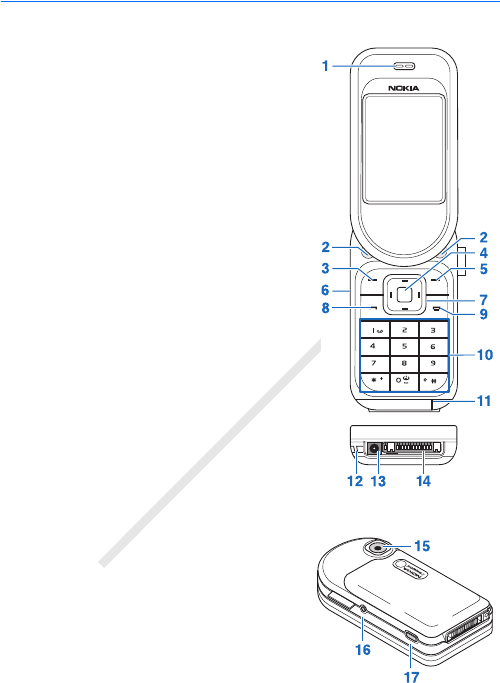
Your phone
16
DRAFT
2. Your phone
■Keys and parts
Earpiece (1)
Twin stereo speakers (2)
Left selection key (3)
Middle selection key (4)
Right selection key (5)
Volume key and zoom key (6)
4-way scroll key (7)
Call key (8)
End key (9)
Keypad (10)
Microphone (11)
Phone strap eyelet (12)
Charger connector (13)
Pop-PortTM connector (14)
Camera lens (15)
Power key (16)
Camera key (17)
RM-209_en_1_FCC.fm Page 16 Thursday, September 7, 2006 12:18 PM
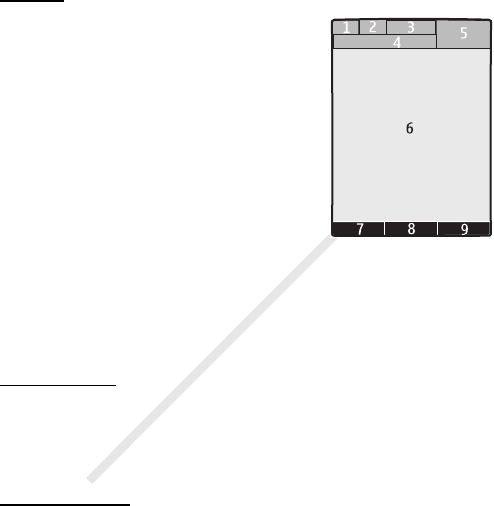
Your phone
17
DRAFT
■Standby mode
When the phone is ready for use, and you have not entered any
characters, the phone is in the standby mode.
Display
Signal strength of the cellular network (1)
Battery charge status (2)
Indicators (3)
Name of the network or the operator logo (4)
Clock (5)
Main screen (6)
Function of left selection key (7) is Go to or a
shortcut to another function. See “Left
selection key,” p. 47.
Function of middle selection key (8) is Menu
Function of right selection key (9) is Music or a shortcut to another
function. See“Right selection key,” p. 48. Operator variants may have an
operator-specific name to access an operator-specific Web site.
Power saving
Your phone has some features in order to save battery power in standby
mode if the phone is not active. These features may be activated or not.
See Power saver and Sleep mode in “Display,” p. 46.
Active standby
In the active standby mode there is a list of selected phone features and
information on the screen that you can directly access. To switch it on or
off, select Menu > Settings > Display > Active standby > Active standby
mode > On or Off.
In the standby mode, scroll up or down to activate the navigation in the
list, and select Select or View. Left and right arrows at the beginning
and end of a line indicate that further information is available by
RM-209_en_1_FCC.fm Page 17 Thursday, September 7, 2006 12:18 PM

Your phone
18
DRAFT
scrolling left or right. To end the active standby navigation mode, select
Exit.
To organize and change the active standby mode, activate the
navigation mode, and select Options and from the available options.
Shortcuts in the standby mode
• To access the list of dialed numbers, press the call key once. Scroll to
the number or name that you want; and to call the number, press the
call key.
• To open the web browser, press and hold 0.
• To call your voice mailbox, press and hold 1.
• Use the scroll key as a shortcut. See “My shortcuts,” p. 47.
Indicators
You have unread messages in the Inbox folder.
You have unsent, canceled or failed messages in the Outbox
folder.
The phone registered a missed call.
/ Your phone is connected to the instant messaging service, and
the availability status is online or offline.
You received one or several instant messages.
The keypad is locked.
The phone does not ring for an incoming call or text message.
The alarm clock is activated
The countdown timer is running.
The stopwatch is running in the background.
/ The phone is registered to the GPRS or EGPRS network.
/ A GPRS or EGPRS connection is established.
RM-209_en_1_FCC.fm Page 18 Thursday, September 7, 2006 12:18 PM

Your phone
19
DRAFT
/ The GPRS or EGPRS connection is suspended (on hold).
A Bluetooth connection is active.
If you have two phone lines, the second phone line is selected.
All incoming calls are diverted to another number.
The loudspeakers are activated, or the music stand is connected
to the phone.
Calls are limited to a closed user group.
The timed profile is selected.
, , , or
A headset, hands-free, loopset, or music stand enhancement is
connected to the phone.
■Flight mode
You can deactivate all radio frequency functionality and still have
access to offline games, calendar, and phone numbers. Use the flight
mode in radio sensitive environments—on board aircraft or in hospitals.
When the flight mode is active, is shown.
Select Menu > Settings > Profiles > Flight > Activate or Personalise.
To deactivate the flight mode, select any other profile.
In the flight mode you can make an emergency call. Enter the
emergency number, press the call key, and select Yes when asked Exit
flight profile? The phone attempts to make an emergency call.
■Keypad lock (keyguard)
To prevent accidental keypresses, select Menu, and press * within 3.5
seconds to lock the keypad.
To unlock the keypad, select Unlock, and press * within 1.5 seconds. If
the Security keyguard is set On, enter the security code if requested.
To answer a call when the keyguard is on, press the call key. When you
end or reject the call, the keypad automatically locks.
RM-209_en_1_FCC.fm Page 19 Thursday, September 7, 2006 12:18 PM

Call functions
20
DRAFT
For Automatic keyguard and Security keyguard, see “Phone,” p. 54.
When the keyguard is on, calls may be possible to the official emergency number
programmed into your device.
■Functions without a SIM card
Several functions of your phone may be used without installing a SIM
card (for example, the data transfer with a compatible PC or another
compatible device). Some functions appear dimmed in the menus and
cannot be used.
For an emergency call, some networks may require that a valid SIM card is
properly inserted in the device.
3. Call functions
■Make a call
1. Enter the phone number, including the area code.
For international calls, press * twice for the international prefix (the
+ character replaces the international access code), enter the
country code, the area code without the leading 0, if necessary, and
the phone number.
2. To call the number, press the call key.
To adjust the volume in a call, press the volume up or down key.
3. To end the call or to cancel the call attempt, press the end key, or
close the phone.
To search for a name or phone number that you have saved in Contacts,
see “Search for a contact,” p. 41. Press the call key to call the number.
To access the list of dialed numbers, press the call key once in the
standby mode. To call the number, select a number or name, and press
the call key.
RM-209_en_1_FCC.fm Page 20 Thursday, September 7, 2006 12:18 PM

Call functions
21
DRAFT
Speed dialing
Assign a phone number to one of the speed-dialing keys, 2 to 9. See
“Speed dials,” p. 44. Call the number in either of the following ways:
• Press a speed-dialing key, then the call key.
•If Speed dialling is set to On, press and hold a speed-dialing key until
the call begins. See Speed dialling in “Call,” p. 53.
Enhanced voice dialing
You can make a phone call by saying the name that is saved in the
contact list of the phone. Voice commands are language-dependent. To
set the language, see Recognition lang. in “Phone,” p. 54.
Note: Using voice tags may be difficult in a noisy environment or
during an emergency, so you should not rely solely upon voice dialing in
all circumstances.
1. In the standby mode, press and hold the right selection key, or press
and hold the volume down key. A short tone is played, and Speak now
is displayed.
2. Say the voice command clearly. If the voice recognition is successful,
a list with matches is shown. The phone plays the voice command of
the match on the top of the list. If the result is not the correct one,
scroll to another entry.
Using voice commands to carry out a selected phone function is
similar to voice dialing. See Voice commands in “My shortcuts,” p. 47.
■Answer or reject a call
To answer an incoming call, press the call key, or open the phone. To end
the call, press the end key, or close the phone.
To reject an incoming call, press the end key. To mute the ringing tone,
select Silence.
RM-209_en_1_FCC.fm Page 21 Thursday, September 7, 2006 12:18 PM

Write text
22
DRAFT
Call waiting
To answer the waiting call during an active call (network service), press
the call key. The first call is put on hold. To end the active call, press the
end key.
To activate the Call waiting function, see “Call,” p. 53.
■Options during a call
Many of the options that you can use during a call are network services.
For availability, contact your service provider.
During a call, select Options and from the following options:
Call options are Mute or Unmute, Contacts, Menu, Lock keypad, Record,
Voice clarity, Loudspeaker or Handset.
Network services options are Answer or Reject, Hold or Unhold, New
call, Add to conference, End call, End all calls, and the following:
Send DTMF — to send tone strings
Swap — to switch between the active call and the call on hold
Transfer — to connect a call on hold to an active call and disconnect
yourself
Conference — to make a conference call
Private call —to discuss privately in a conference call
Warning: Do not hold the device near your ear when the loudspeaker
is in use, because the volume may be extremely loud.
4. Write text
To enter text (for example, when writing messages), use traditional or
predictive text input. When you write text, press and hold Options to
toggle between traditional text input, indicated by , and predictive
text input, indicated by . Not all languages are supported by
predictive text input.
RM-209_en_1_FCC.fm Page 22 Thursday, September 7, 2006 12:18 PM

Write text
23
DRAFT
The character cases are indicated by , , and . To change the
character case, press #. To change from the letter to number mode,
indicated by , press and hold #, and select Number mode. To change
from the number to the letter mode, press and hold #.
To set the writing language, select Options > Writing language.
■Traditional text input
Press a number key, 1 to 9, repeatedly until the desired character
appears. The characters available depend on the selected writing
language. If the next letter you want is located on the same key as the
present one, wait until the cursor appears and enter the letter. The most
common punctuation marks and special characters are available under
the number key 1.
■Predictive text input
Predictive text input is based on a built-in dictionary to which you can
also add new words.
1. Start writing a word, using the keys 2 to 9. Press each key only once
for one letter.
2. When you finish writing the word and it is correct, to confirm it by
adding a space, press 0.
If the word is not correct, press * repeatedly, and select the word
from the list.
If the ? character is displayed after the word, the word you intended
to write is not in the dictionary. To add the word to the dictionary,
select Spell. Enter the word using traditional text input, and select
Save.
To write compound words, enter the first part of the word, and press
the scroll key right to confirm it. Write the last part of the word, and
confirm the word.
3. Start writing the next word.
RM-209_en_1_FCC.fm Page 23 Thursday, September 7, 2006 12:18 PM

Navigate the menus
24
DRAFT
5. Navigate the menus
The phone offers you an extensive range of functions, which are
grouped into menus.
1. To access the menu, select Menu.
To change the menu view, select Options > Main menu view > List,
Grid, Grid with labels, or Tab.
To rearrange the menu, scroll to the menu you want to move, and
select Options > Organise > Move. Scroll to where you want to
move the menu, and select OK. To save the change, select Done >
Yes.
2. Scroll through the menu, and select an option (for example,
Settings).
3. If the selected menu contains further submenus, select the one that
you want (for example, Call).
4. If the selected menu contains further submenus, repeat step 3.
5. Select the setting of your choice.
6. To return to the previous menu level, select Back. To exit the menu,
select Exit.
RM-209_en_1_FCC.fm Page 24 Thursday, September 7, 2006 12:18 PM

Messaging
25
DRAFT
6. Messaging
You can read, write, send, and save text, multimedia, e-mail, audio, and
flash messages and postcards. All messages are organized into folders.
■Text message
With the short message service (SMS) you can send and receive text
messages, and receive messages that can contain pictures (network
service).
Before you can send any text or SMS e-mail message, you must save
your message center number. See “Message settings,” p. 38.
To check SMS e-mail service availability and to subscribe to the service,
contact your service provider. To save an e-mail address in Contacts, see
“Save details,” p. 41.
Your device supports the sending of text messages beyond the character limit for
a single message. Longer messages will be sent as a series of two or more
messages. Your service provider may charge accordingly. Characters that use
accents or other marks, and characters from some language options like Chinese,
take up more space limiting the number of characters that can be sent in a single
message.
An indicator at the top of the display shows the total number of
characters left and the number of messages needed for sending. For
example, 673/2 means that there are 673 characters left and that the
message will be sent as a series of 2 messages.
Write and send a message
1. Select Menu > Messaging > Create message > Text message.
2. Enter one or more phone numbers or e-mail addresses in the To: field.
To retrieve a phone number or e-mail address from a memory, select
Add.
3. For a SMS e-mail, enter a subject in the Subject: field.
4. Write your message in the Message: field.
5. To send the message, select Send. See “Message sending,” p. 27.
RM-209_en_1_FCC.fm Page 25 Thursday, September 7, 2006 12:18 PM
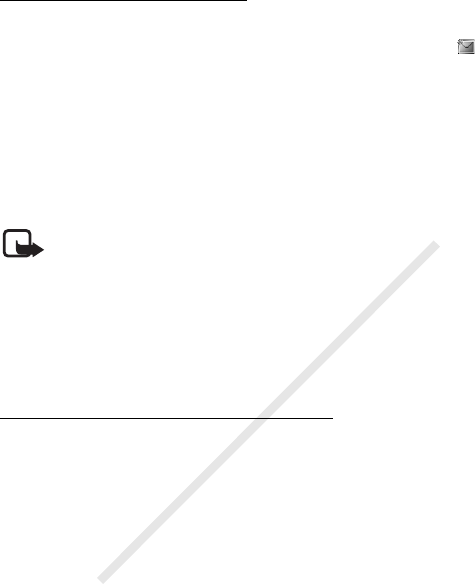
Messaging
26
DRAFT
Read and reply to a message
1. To view a received message, select Show. To view it later, select Exit.
To read the message later, select Menu > Messaging > Inbox. is
shown if you have unread messages in Inbox.
2. To reply to a message, select Reply and the message type.
3. Create the reply message.
4. To send the message, select Send. See “Message sending,” p. 27.
■Multimedia message
Note: Only devices that have compatible features can receive and
display multimedia messages. The appearance of a message may vary
depending on the receiving device.
A multimedia message can contain some attachments.
To check availability and to subscribe to the multimedia messaging
service (MMS), contact your service provider. See “Message settings,”
p. 38.
Write and send a multimedia message
The wireless network may limit the size of MMS messages. If the inserted image
exceeds this limit, the device may make it smaller so that it can be sent by MMS.
1. Select Menu > Messaging > Create message > Multimedia.
2. Write your message.
Your phone supports multimedia messages that contain several
pages (slides). A message can contain a calendar note and a business
card as attachments. A slide can contain text, one image, and one
sound clip; or text and a video clip. To insert a slide in the message,
select New; or select Options > Insert > Slide.
To insert a file in the message, select Insert; or select Options >
Insert.
3. To view the message before sending it, select Options > Preview.
4. To send the message, select Send. See “Message sending,” p. 27.
RM-209_en_1_FCC.fm Page 26 Thursday, September 7, 2006 12:18 PM

Messaging
27
DRAFT
5. Enter one or more phone numbers or e-mail addresses in the To: field.
To retrieve a phone number or e-mail address from a memory, select
Add.
6. To send the message, select Send. See “Message sending,” p. 27.
Write and send a multimedia plus message
The wireless network may limit the size of MMS messages. If the inserted image
exceeds this limit, the device may make it smaller so that it can be sent by MMS.
Any content can be added to the multimedia plus message. Such
content might be images, video clips, sound clips, business cards,
calendar notes, themes, streaming links, or even unsupported files (for
example, files received with an e-mail).
1. Select Menu > Messaging > Create message > Multimedia plus.
2. Enter one or more phone numbers or e-mail addresses in the To: field.
To retrieve a phone number or e-mail address from a memory, select
Add.
3. Enter a subject and write your message.
4. To add a file, select Insert and from the options.
5. To view the message before sending it, select Options > Preview.
6. To send the message, select Send. See “Message sending,” p. 27.
Message sending
Copyright protections may prevent some images, music (including ringing tones),
and other content from being copied, modified, transferred or forwarded.
To send the message, select Send. The phone saves the message in the
Outbox folder, and the sending starts.
Note: When the phone is sending the message, the animated is
shown. This is an indication that the message has been sent by your
device to the message center number programmed into your device.
This is not an indication that the message has been received at the
intended destination. For more details about messaging services, check
with your service provider.
If an interruption occurs while the message is being sent, the phone
tries to resend the message a few times. If these attempts fail, the
RM-209_en_1_FCC.fm Page 27 Thursday, September 7, 2006 12:18 PM

Messaging
28
DRAFT
message remains in the Outbox folder. To cancel the sending of the
messages in the Outbox folder, scroll to the desired message, and select
Options > Cancel sending.
Read and reply to a message
Important: Exercise caution when opening messages. Multimedia
message objects may contain malicious software or otherwise be
harmful to your device or PC.
1. To view the received message, select Show. To view it later, select
Exit.
2. To view the whole message if the received message contains a
presentation, select Play.
To view the files in the presentation or the attachments, select
Options > Objects or Attachments.
3. To reply to the message, select Options > Reply and the message
type.
4. Create the reply message.
5. To send the message, select Send. See “Message sending,” p. 27.
■Postcards
With the postcard messaging service (network service), create and send
postcards that may contain an image and a greeting text. The postcard
is sent to the service provider using multimedia messaging. The service
provider prints the postcard and sends it to the postal address given
with the message. MMS must be activated before this service can be
used.
Before you can use the postcard service you must subscribe to the service. To
check the availability, and costs, and to subscribe to the service, contact your
network operator or service provider.
To send a postcard, select Menu > Messaging > Create message >
Postcard. Fill in the address, mandatory editor fields are marked by a *.
Scroll to the image field, select Insert and an image from the gallery, or
New image to insert a recent image; then write your greeting text. To
send the message, select Send.
RM-209_en_1_FCC.fm Page 28 Thursday, September 7, 2006 12:18 PM

Messaging
29
DRAFT
■Flash messages
Flash messages are text messages that are instantly displayed upon
reception. Flash messages are not automatically saved.
Write a message
Select Menu > Messaging > Create message > Flash message. Enter the
recipient’s phone number and write your message. The maximum length
of a flash message is 70 characters. To insert a blinking text into the
message, select Options > Insert blink charact. to set a marker. The text
behind the marker blinks. To end the blinking text range insert a second
marker.
Receive a message
A received flash message is indicated with Message: and a few words
from the beginning of the message. To read the message, select Read. To
extract numbers and addresses from the current message, select
Options > Use detail. To save the message, select Save and the folder in
which you want to save it.
■Nokia Xpress audio messaging
You can use the MMS to create and send a audio message in a
convenient way. MMS must be activated before you can use audio
messages.
Create a message
1. Select Menu > Messaging > Create message > Audio message. The
recorder opens. To use the recorder, see “Voice recorder,” p. 66.
2. Speak your message.
3. Enter one or more phone numbers in the To: field, or select Add to
retrieve a number.
4. To send the message, select Send.
RM-209_en_1_FCC.fm Page 29 Thursday, September 7, 2006 12:18 PM

Messaging
30
DRAFT
Listen to a message
To open a received audio message, select Play; or if more than one
message is received, select Show > Play. To listen to the message later,
select Exit.
■Memory full
When you receive a message, and the memory for the messages is full,
Memory full. Unable to receive messages. is shown. To first delete old
messages, select OK > Yes and the folder. Scroll to the desired message,
and select Delete. If more messages are to be deleted, select Mark. Mark
all the messages you want to delete, and select Options > Delete
marked.
■Folders
The phone saves received messages in the Inbox folder.
Messages that have not yet been sent are saved in the Outbox folder.
To set the phone to save the sent messages in the Sent items folder, see
Save sent messages in “General settings,” p. 38.
To edit and send messages that you have written and saved in the Drafts
folder, select Menu > Messaging > Drafts.
You can move your messages to the Saved items folder. To organize your
Saved items subfolders, select Menu > Messaging > Saved items. To add
a folder, select Options > Add folder. To delete or rename a folder, scroll
to the desired folder, and select Options > Delete folder or Rename
folder.
Your phone has templates. To create a new template, save a message as
a template. To access the template list, select Menu > Messaging >
Saved items > Templates.
■E-mail application
The e-mail application uses a packet data connection (network service)
to allow you to access your e-mail account. This e-mail application is
RM-209_en_1_FCC.fm Page 30 Thursday, September 7, 2006 12:18 PM

Messaging
31
DRAFT
different from the SMS e-mail function. To use the e-mail function on
your phone, you need a compatible e-mail system.
You can write, send, and read e-mail with your phone. Your phone
supports POP3 and IMAP4 e-mail servers.
Before you can send and retrieve any e-mail messages, you must obtain
a new e-mail account or use your current account. To check the
availability of your e-mail account, contact your e-mail service provider.
Check your e-mail settings with your e-mail service provider. You may
receive the e-mail configuration settings as a configuration message.
See “Configuration settings service,” p. 10.
To activate the e-mail settings, select Menu > Messaging > Message
settings > E-mail messages. See “E-mail messages,” p. 40.
This application does not support keypad tones.
Setting wizard
The setting wizard will start automatically if no e-mail settings are
defined in the phone. To enter the settings manually, select Menu >
Messaging > E-mail > Options > Manage accounts > Options > New.
The Manage accounts options allow you to add, delete, and change the
e-mail settings.
Write and send an e-mail
You can write your e-mail message before connecting to the e-mail
service; or connect to the service first, then write and send your e-mail.
1. Select Menu > Messaging > E-mail > Write new e-mail.
2. If more than one e-mail account is defined, select the account from
which you want to send the e-mail.
3. Enter the recipient’s e-mail address, write the subject, and enter the
e-mail message. To attach a file from Gallery, select Options >
Attach file.
4. To send the e-mail message, select Send > Send now.
RM-209_en_1_FCC.fm Page 31 Thursday, September 7, 2006 12:18 PM

Messaging
32
DRAFT
To save the e-mail in the Outbox folder to be sent later, select
Send > Send later.
To edit or continue writing your e-mail later, select Options > Save
as draft. The e-mail is saved in Outboxes > Drafts.
To send the e-mail later, select Menu > Messaging > E-mail >
Options > Send e-mail or Send / check e-mail.
Download e-mail
1. To download e-mail messages that have been sent to your e-mail
account, select Menu > Messaging > E-mail > Check new e-mail.
If more than one e-mail account is defined, select the account from
which you want to download the e-mail.
The e-mail application only downloads e-mail headers at first.
2. Select Back > Inboxes, the account name, and the new message, and
select Retrieve to download the complete e-mail message.
To download new e-mail messages and to send e-mail that has been
saved in the Outbox folder, select Options > Send / check e-mail
Read and reply to e-mail
Important: Exercise caution when opening messages. E-mail messages
may contain malicious software or otherwise be harmful to your device
or PC.
1. Select Menu > Messaging > E-mail > Inboxes, the account name,
and the desired message.
2. To reply to an e-mail, select Reply > Original text or Empty message.
To reply to many, select Options > Reply to all. Confirm or edit the
e-mail address and subject; then write your reply.
3. To send the message, select Send > Send now.
E-mail folders
Your phone saves e-mail that you have downloaded from your e-mail
account in the Inboxes folder. The Inboxes folder contains the following
folders: “Account name” for incoming e-mail, Archive for archiving
RM-209_en_1_FCC.fm Page 32 Thursday, September 7, 2006 12:18 PM

Messaging
33
DRAFT
e-mail, Custom 1—Custom 3 for sorting e-mail, and Junk where all spam
e-mail is stored. The Outboxes folder contains the following folders:
Drafts for saving unfinished e-mail, Outbox for saving e-mail that has
not been sent, and Sent items for saving e-mail that has been sent.
To manage the folders and their e-mail content, select Options to view
the available options of each folder.
Spam filter
To activate and define a spam filter, select Options > Spam filter >
Settings in the main e-mail idle screen. The spam filter allows you to put
specific senders on a black or white list. Black list sender messages are
filtered to the Junk folder. Unknown and white list sender messages are
downloaded into the account inbox. To blacklist a sender, select the
e-mail message in the Inboxes folder and Options > Blacklist sender.
■Instant messaging
With instant messaging (IM) (network service) you can send short,
simple text messages to online users. You have to subscribe to a service
and register with the IM service you want to use. For more information
about signing up for IM services, contact your service provider.
To set the required settings for the IM service, see Connection settings in
“Access,” p. 33. The icons and texts on the display may vary, depending
on the IM service.
Note: Depending on your IM service, you may not have access to
all of the features described in this guide.
Access
Select Menu > Messaging > IMs. IMs may be replaced by another term
depending on the service provider. If more than one set of connection
settings for IM service is available, select the one you want. Select from
the following options:
Login — to connect to the IM service. To set the phone to automatically
connect to the IM service when you switch on the phone; in the login
session, select Automatic login: > On, or select Menu > Messaging >
RM-209_en_1_FCC.fm Page 33 Thursday, September 7, 2006 12:18 PM

Messaging
34
DRAFT
IMs, connect to the IM service, and select Options > Settings >
Automatic login > On.
Saved conversations — to view, erase, or rename the conversations that
you saved during an IM session
Connection settings — to edit the settings needed for messaging and
presence connection
Connect
To connect to the service, access the instant messages menu, select the
IM service, if needed, and select Login.
To disconnect from the IM service, select Options > Logout.
Sessions
When connected to the service, your status, as seen by others, is shown
in a status line: My status: Online, My status: Busy or Status: Appear off..
To change your own status, select Change.
Below the status line there are three folders that contain your contacts
and showing their status: Conversations, Online and Offline. To expand
the folder, highlight it, and select Expand (or scroll right); to collapse
the folder, select Collapse (or scroll left).
Conversations — shows the list of new and read instant messages or
invitations to IM during the active IM session.
indicates a new group message.
indicates a read group message.
indicates a new instant message.
indicates a read instant message.
indicates an invitation.
The icons and texts on the display depends on the IM service.
Online — shows the number of contacts that are online
Offline — shows the number of contacts that are offline
To start a conversation, expand the Online or the Offline folder, scroll to
the contact with whom you would like to chat, and select Chat. To
RM-209_en_1_FCC.fm Page 34 Thursday, September 7, 2006 12:18 PM

Messaging
35
DRAFT
answer an invitation, or to reply to a message, expand the Conversations
folder, scroll to the contact to whom you would like to chat, and select
Open. To add contacts, see “Add IM contacts,” p. 36.
Groups > Public groups (not visible if groups are not supported by the
network) — The list of bookmarks to public groups provided by the
service provider is displayed. To start a IM session with a group, scroll to
a group, and select Join. Enter the screen name that you want to use as
your nickname in the conversation. When you have successfully joined
the group conversation, you can start a group conversation. You can
create a private group. See “Groups,” p. 36.
Search > Users or Groups — to search for other IM users or public groups
on the network by phone number, screen name, e-mail address, or name.
If you select Groups, you can search for a group by a member in the
group, or by group name, topic, or ID.
Options > Chat or Join group — to start the conversation when you have
found the user or the group that you want
Accept or reject an invitation
If you receive a new invitation, to read it, select Read. If more than one
invitation is received, select an invitation and Open. To join the private
group conversation, select Accept, and enter the screen name you want
to use as your nickname. To reject or delete the invitation, select
Options > Reject or Delete.
Read an instant message
If you receive a new message that is not a message associated with an
active conversation, New instant message is displayed. To read it, select
Read. If more than one message is received, select a message and Open.
New messages received during an active conversation are held in IMs >
Conversations. If you receive a message from someone who is not in IM
contacts, the sender ID is displayed. To save a new contact that is not in
the phone memory, select Options > Save contact.
RM-209_en_1_FCC.fm Page 35 Thursday, September 7, 2006 12:18 PM

Messaging
36
DRAFT
Participate in a conversation
To join or start an IM session, write your message, and select Send.
If you receive a new message during a conversation from a person who
is not taking part in the current conversation, is displayed, and the
phone sounds an alert tone.
Write your message, and select Send. Your message is displayed, and the
reply message is displayed below your message.
Add IM contacts
When connected to the IM service, in the IM main menu, select
Options > Add contact > By mobile number, Enter ID manually, Search
from server, or Copy from server (depending on service provider).
Scroll to a contact. To start a conversation, select Chat.
Block or unblock messages
When you are in a conversation and want to block messages, select
Options > Block contact.
To block messages from a specific contact in your contacts list, scroll to
the contact in Conversations, Online, or Offline, and select Options >
Block contact > OK.
To unblock a contact, in the IM main menu, select Options > Blocked
list. Scroll to the contact you want to unblock, and select Unblock > OK.
Groups
You can use the public groups provided by the service provider, or create
your own private groups for an IM conversation.
Public
You can bookmark public groups that your service provider may
maintain. Connect to the IM service, and select Groups > Public groups.
Select a group and Join. If you are not in the group, enter your screen
name as your nickname for the group. To delete a group from your list,
select Options > Delete group.
To search for a group, select Groups > Public groups > Search groups.
RM-209_en_1_FCC.fm Page 36 Thursday, September 7, 2006 12:18 PM

Messaging
37
DRAFT
Private
Connect to the IM service, and from the main menu, select Options >
Create group. Enter the name for the group and the screen name that
you want to use as your nickname. Mark the private group members in
the contacts list, and write an invitation.
■Voice messages
The voice mailbox is a network service to which you may need to
subscribe. For more information contact your service provider.
To call your voice mailbox, select Menu > Messaging > Voice
messages > Listen to voice msgs.. To enter, search for, or edit your voice
mailbox number, select Voice mailbox no..
If supported by the network, indicates new voice messages. To call
your voice mailbox number, select Listen.
■Info messages
You can receive messages on various topics from your service provider
(network service). For more information, contact your service provider.
Select Menu > Messaging > Info messages and from the available
options.
■Service commands
Write and send service requests (USSD commands) to your service
provider, such as activation commands for network services. Select
Menu > Messaging > Serv. commands.
■Delete messages
To delete messages, select Menu > Messaging > Delete messages > By
message to delete single messages, By folder to delete all messages from
a folder, or All messages.
RM-209_en_1_FCC.fm Page 37 Thursday, September 7, 2006 12:18 PM

Messaging
38
DRAFT
■SIM messages
SIM messages are specific text messages that are saved to your SIM
card. You can copy or move those messages from the SIM to the phone
memory, but not vice versa. To read SIM messages, select Menu >
Messaging > Options > SIM messages.
■Message settings
General settings
General settings are common for text and multimedia messages.
Select Menu > Messaging > Message settings > General settings and
from the following options:
Save sent messages > Yes — to set the phone to save the sent messages
in the Sent items folder
Overwriting in Sent > Allowed — to set the phone to overwrite the old
sent messages with the new ones when the message memory is full. This
setting is shown only if you set Save sent messages > Yes.
Font size — to select the font size used in messages
Graphical smileys > Yes — to set the phone to replace character-based
smileys with graphical ones
Text messages
The text message settings affect the sending, receiving, and viewing of
text and SMS e-mail messages.
Select Menu > Messaging > Message settings > Text messages and
from the following options:
Delivery reports > Yes — to ask the network to send delivery reports
about your messages (network service)
Message centres > Add centre — to set the phone number and name of
the message center that is required for sending text messages. You
receive this number from your service provider.
Msg. centre in use — to select the message center in use
RM-209_en_1_FCC.fm Page 38 Thursday, September 7, 2006 12:18 PM

Messaging
39
DRAFT
E-mail msg. centres > Add centre — to set the phone numbers and name
of the e-mail center for sending SMS e-mails.
E-mail centre in use — to select the SMS e-mail message center in use
Message validity — to select the length of time for which the network
attempts to deliver your message
Messages sent via — to select the format of the messages to be sent:
Text, Paging, or Fax (network service)
Use packet data > Yes — to set GPRS as the preferred SMS bearer
Character support > Full — to select all characters in the messages to be
sent as viewed. If you select Reduced, characters with accents and other
marks may be converted to other characters.
Rep. via same centre > Yes — to allow the recipient of your message to
send you a reply using your message center (network service)
Multimedia messages
The message settings affect the sending, receiving, and viewing of
multimedia messages. You may receive the configuration settings for
multimedia messaging as a configuration message. See “Configuration
settings service,” p. 10. You can also enter the settings manually. See
“Configuration,” p. 55.
Select Menu > Messaging > Message settings > Multimedia messages
and from the following options:
Delivery reports > Yes — to ask the network to send delivery reports
about your messages (network service)
Img. size (MMS plus) — to set the image size in multimedia plus
messages
Image size (MMS) — to set the image size in multimedia messages
Default slide timing — to define the default time between slides in
multimedia messages
Allow MMS receptn. > Yes or No — to receive or block the multimedia
message. If you select In home network, you cannot receive multimedia
messages when outside your home network. The default setting of the
RM-209_en_1_FCC.fm Page 39 Thursday, September 7, 2006 12:18 PM

Messaging
40
DRAFT
multimedia message service is generally In home network. The
availability of this menu depends on your phone.
Incoming MMS msgs. — to allow the reception of multimedia messages
automatically, manually after being prompted, or to reject the
reception. This setting is not shown if Allow MMS receptn. is set to No.
Allow adverts — to receive or reject advertisements. This setting is not
shown if Allow MMS receptn. is set to No, or Incoming MMS msgs. is set
to Reject.
Configuration sett. > Configuration — Only the configurations that
support multimedia messaging are shown. Select a service provider,
Default, or Personal config. for multimedia messaging. Select Account
and a MMS account contained in the active configuration settings.
E-mail messages
The settings affect the sending, receiving, and viewing of e-mail. You
may receive the settings as a configuration message. See “Configuration
settings service,” p. 10. You can also enter the settings manually. See
“Configuration,” p. 55.
Select Menu > Messaging > Message settings > E-mail messages and
from the following options:
Configuration — to select the set that you want to activate
Account — to select an account provided by the service provider
My name — to enter your name or nickname
E-mail address — to enter your e-mail address
Login information — to enter information according to the server type
Incoming mail sett. — to select the maximum number of e-mails to be
retrieved
Outgoing sett. (SMTP) — to enter SMTP (simple mail transfer protocol)
settings
Displ. term. window > Yes — to perform manual user authentication for
intranet connections
RM-209_en_1_FCC.fm Page 40 Thursday, September 7, 2006 12:18 PM

Contacts
41
DRAFT
7. Contacts
You can save names and phone numbers (contacts) in the
phone memory and in the SIM card memory.
The phone memory may save contacts with additional details, such as
various phone numbers and text items. You can also save an image for a
limited number of contacts.
The SIM card memory can save names with one phone number attached
to them. The contacts saved in the SIM card memory are indicated by
.
■Search for a contact
Select Menu > Contacts > Names. Scroll through the list of contacts, or
enter the first characters of the name you are searching for.
■Save names and phone numbers
Names and numbers are saved in the used memory. To save a name and
phone number, select Menu > Contacts > Names > Options > Add new
contact.
■Save details
In the phone memory, you can save different types of phone numbers, a
tone or a video clip, and short text items for a contact.
The first number you save is automatically set as the default number
and is indicated with a frame around the number type indicator (for
example, ). When you select a name from contacts (for example, to
make a call), the default number is used unless you select another
number.
Make sure that the memory in use is Phone or Phone and SIM. See
“Settings,” p. 43.
Search for the contact to which you want to add a detail, and select
Details > Options > Add detail. Select from the options available.
RM-209_en_1_FCC.fm Page 41 Thursday, September 7, 2006 12:18 PM

Contacts
42
DRAFT
■Copy or move contacts
To copy or move a contact from the phone contact memory to the SIM
card memory, or vice versa, select Menu > Contacts > Names. Select the
contact to copy or move and Options > Copy contact or Move contact.
To copy or move several contacts, select the first contact to copy or
move and Options > Mark. Mark the other contacts, and select
Options > Copy marked or Move marked.
To copy or move all contacts from the phone contact memory to the SIM
card memory, or vice versa, select Menu > Contacts > Copy contacts or
Move contacts.
The SIM card memory can save names with one phone number attached
to them.
■Edit contact details
Search for the contact, and select Details. To edit a name, number, or
text item or to change the image, select Options > Edit. To change the
number type, scroll to the desired number, and select Options > Change
type. To set the selected number as the default number, select Set as
default.
■Synchronize all
Synchronize your calendar, contacts data, and notes with a remote
Internet server (network service). For details see “Synchronize from a
server,” p. 52.
■Delete contacts
To delete all the contacts and the details attached to them from the
phone or SIM card memory, select Menu > Contacts > Del. all
contacts > From phone memory or From SIM card.
To delete a contact, search for the desired contact, and select Options >
Delete contact.
RM-209_en_1_FCC.fm Page 42 Thursday, September 7, 2006 12:18 PM

Contacts
43
DRAFT
To delete a number, text item, or an image attached to the contact,
search for the contact, and select Details. Scroll to the desired detail,
and select Options > Delete and from the options available.
■Business cards
You can send and receive a person’s contact information from a
compatible device that supports the vCard standard as a business card.
To send a business card, search for the contact whose information you
want to send, and select Details > Options > Send business card.
When you have received a business card, select Show > Save to save the
business card in the phone memory. To discard the business card, select
Exit > Yes.
■Settings
Select Menu > Contacts > Settings and from the following options:
Memory in use — to select the SIM card or phone memory for your
contacts. Select Phone and SIM to recall names and number from both
memories. In that case, when you save names and numbers, they are
saved in the phone memory.
Contacts view — to select how the names and numbers in Contacts are
displayed
Name display — to select whether the contact’s first or last name is
displayed first
Font size — to set the font size for the list of contacts
Memory status — to view the free and used memory capacity
■Groups
Select Menu > Contacts > Groups to arrange the names and phone
numbers saved in the memory into caller groups with different ringing
tones and group images.
RM-209_en_1_FCC.fm Page 43 Thursday, September 7, 2006 12:18 PM

Call log
44
DRAFT
■Speed dials
To assign a number to a speed-dialing key, select Menu > Contacts >
Speed dials, and scroll to the speed-dialing number that you want.
Select Assign, or if a number has already been assigned to the key,
select Options > Change. Select Search and the contact you want to
assign. If the Speed dialling function is off, the phone asks whether you
want to activate it. See also Speed dialling in “Call,” p. 53.
To make a call using the speed-dialing keys, see “Speed dialing,” p. 21.
■Info, service, and my numbers
Select Menu > Contacts and from one of these submenus:
Info numbers — to call the information numbers of your service provider
if the numbers are included on your SIM card (network service)
Service numbers — to call the service numbers of your service provider if
the numbers are included on your SIM card (network service)
My numbers — to view the phone numbers assigned to your SIM card, if
the numbers are included on your SIM card
8. Call log
The phone registers your missed, received, and dialed calls if the
network supports it and the phone is switched on and within the
network service area.
To view the information on your calls, select Menu > Log > Missed calls,
Received calls, or Dialled numbers. To view your recent missed and
received calls and the dialed numbers chronologically, select Call log. To
view the contacts to whom you most recently sent messages, select
Msg. recipients.
To view the approximate information on your recent communications,
select Menu > Log > Call duration, Data counter, or Pack. data timer.
To view how many text and multimedia messages you have sent and
received, select Menu > Log > Message log.
RM-209_en_1_FCC.fm Page 44 Thursday, September 7, 2006 12:18 PM
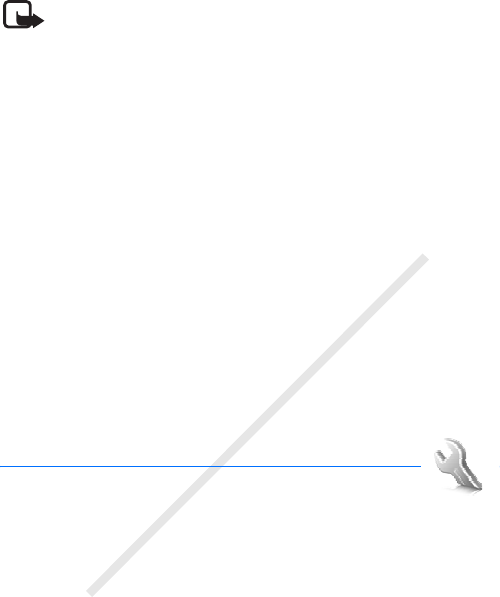
Settings
45
DRAFT
Note: The actual invoice for calls and services from your service
provider may vary, depending on network features, rounding off for
billing, taxes, and so forth.
Some timers may be reset during service or software upgrades.
■Location information
The network may send you a location request (network service). Contact
your service provider to subscribe and to agree upon the delivery of
location information.
To accept or reject the location request, select Accept or Reject. If you
miss the request, the phone automatically accepts or rejects it
according to what you have agreed with your network operator or
service provider. The phone displays 1 missed position request. To view
the missed location request, select Show.
To view the information on the 10 most recent privacy notifications and
requests or to delete them, select Menu > Log > Positioning > Position
log > Open folder or Delete all.
9. Settings
■Profiles
Your phone has various setting groups called profiles, for which you can
customize the phone tones for different events and environments.
Select Menu > Settings > Profiles, the desired profile and from the
following options:
Activate — to activate the selected profile
Personalise — to personalize the profile. Select the setting you want to
change, and make the changes.
Timed — to set the profile to be active until a certain time (up to
24 hours) and set the end time. When the time set for the profile
expires, the previous profile that was not timed becomes active.
RM-209_en_1_FCC.fm Page 45 Thursday, September 7, 2006 12:18 PM

Settings
46
DRAFT
■Themes
A theme contains elements for personalizing your phone.
Select Menu > Settings > Themes and from the following options:
Select theme — to set a theme. A list of folders in Gallery opens. Open
the Themes folder, and select a theme.
Theme downloads — to open a list of links to download more themes
■Tones
You can change the tone settings of the selected active profile.
Select Menu > Settings > Tones. You can find the same settings in the
Profiles menu. See Personalise in “Profiles,” p. 45.
To set the phone to ring only for calls from phone numbers that belong
to a selected caller group, select Alert for. Scroll to the caller group you
want or All calls, and select Mark.
Select Options > Save to save the settings or Cancel to leave the
settings unchanged.
If you select the highest ringing tone level, the ringing tone reaches its highest
level after a few seconds.
■Display
Select Menu > Settings > Display and from the available options:
Wallpaper — to add the background image in the standby mode
Active standby — to switch the active standby mode on or off and to
organize and personalize the active standby mode
Standby font colour — to select the color for the texts in the standby
mode
Navigation key icons — to display the icons of the current scroll key
shortcuts in the standby mode when active standby is off
Swivel animation — to set your phone to display an animation and
sound a tone when you open and close the phone depending on the
theme
RM-209_en_1_FCC.fm Page 46 Thursday, September 7, 2006 12:18 PM

Settings
47
DRAFT
Screen saver > On — to set your phone to display a screen saver. To
download more screen savers, select Graphic downloads. To set the time
after which the screen saver is activated, select Time-out.
Power saver — to save some battery power. The date and a digital clock
are displayed when no function of the phone is used for a certain time.
Sleep mode — to save some battery power. The display turns completely
black when no function of the phone is used for a certain time.
Font size — to set the font size for messaging, contacts, and web pages
Operator logo — to set your phone to display or hide the operator logo
Cell info display > On — to display the cell identity, if available from the
network
■Time and date
To change the clock type, time, time zone, and date settings, select
Menu > Settings > Time and date > Time, Date, or Auto-update of time
(network service).
When traveling to a different time zone, select Menu > Settings > Time
and date > Time > Time zone and the time zone of your location in terms
of the time difference with respect to Greenwich Mean Time (GMT) or
Universal Time Coordinated (UTC). The time and date are set according
to the time zone and enable your phone to display the correct sending
time of received text or multimedia messages. For example, GMT -5
denotes the time zone for New York (USA), 5 hours west of Greenwich,
London (UK).
■My shortcuts
With personal shortcuts you get quick access to often used functions of
the phone.
Left selection key
To select a function from the list, select Menu > Settings > My
shortcuts > Left selection key.
RM-209_en_1_FCC.fm Page 47 Thursday, September 7, 2006 12:18 PM

Settings
48
DRAFT
If the left selection key is Go to to activate a function, in the standby
mode, select Go to > Options and from the following options:
Select options — to add a function to the shortcut list or to remove one
Organise — to rearrange the functions on your personal shortcut list
Right selection key
To select a function from the list, select Menu > Settings > My
shortcuts > Right selection key.
Navigation key
To assign other phone functions from a predefined list to the navigation
key (scroll key), select Menu > Settings > My shortcuts > Navigation
key.
Voice commands
To call contacts and carry out phone functions, say the voice commands.
Voice commands are language-dependent. To set the language, see
Recognition lang. in “Phone,” p. 54.
To select the phone functions to activate with a voice commands, select
Menu > Settings > My shortcuts > Voice commands and a folder. Scroll
to a function. indicates that the voice tag is activated. To activate
the voice tag, select Add. To play the activated voice command, select
Play. To use voice commands, see “Enhanced voice dialing,” p. 21.
To manage the voice commands, scroll to a phone function, and select
from the following options:
Edit or Remove — to change or deactivate the voice command of the
selected function
Add all or Remove all — to activate or deactivate voice commands to all
functions in the voice commands list
RM-209_en_1_FCC.fm Page 48 Thursday, September 7, 2006 12:18 PM

Settings
49
DRAFT
■Connectivity
You can connect the phone to a compatible device using a Bluetooth
wireless technology or a USB data cable connection. You can also define
the settings for EGPRS dial-up connections.
Bluetooth wireless technology
This device is compliant with Bluetooth Specification 2.0 + EDR supporting the
following profiles: generic access, network access, generic object exchange,
hands-free, headset, object push, file transfer, dial-up networking, SIM access,
and serial port. To ensure interoperability between other devices supporting
Bluetooth technology, use Nokia approved enhancements for this model. Check
with the manufacturers of other devices to determine their compatibility with
this device.
There may be restrictions on using Bluetooth technology in some locations.
Check with your local authorities or service provider.
Features using Bluetooth technology or allowing such features to run in the
background while using other features, increase the demand on battery power
and reduce the battery life.
Bluetooth technology allows you to connect the phone to a compatible
Bluetooth device within 10 meters (32 feet). Since devices using
Bluetooth technology communicate using radio waves, your phone and
the other devices do not need to be in direct line-of-sight, although the
connection can be subject to interference from obstructions such as
walls or from other electronic devices.
Set up a Bluetooth connection
Select Menu > Settings > Connectivity > Bluetooth and from the
following options:
Bluetooth > On or Off — to activate or deactivate the Bluetooth
function. indicates that Bluetooth is activated.
Search audio enhanc. — to search for compatible Bluetooth audio
devices. Select the device that you want to connect to the phone.
Paired devices — to search for any Bluetooth device in range. Select New
to list any Bluetooth device in range. Select a device and Pair. Enter an
agreed Bluetooth passcode of the device (up to 16 characters) to pair
RM-209_en_1_FCC.fm Page 49 Thursday, September 7, 2006 12:18 PM

Settings
50
DRAFT
the device to your phone. You must only give this passcode when you
connect to the device for the first time. Your phone connects to the
device, and you can start data transfer.
Bluetooth wireless connection
Select Menu > Settings > Connectivity > Bluetooth. To check which
Bluetooth connection is currently active, select Active devices. To view a
list of Bluetooth devices that are currently paired with the phone, select
Paired devices.
Bluetooth settings
To define how your phone is shown to other Bluetooth devices, select
Menu > Settings > Connectivity > Bluetooth > My phone's visibility or
My phone's name.
If you are concerned about security, turn off the Bluetooth function, or set My
phone's visibility to Hidden. Always accept only Bluetooth communication from
others with whom you agree.
Packet data
General packet radio service (GPRS) is a network service that allows
mobile phones to send and receive data over an Internet protocol
(IP)-based network.
To define how to use the service, select Menu > Settings >
Connectivity > Packet data > Packet data conn. and from the following
options:
When needed — to set the packet data connection to established when
an application needs it. The connection will be closed when the
application is terminated.
Always online — to set the phone to automatically connect to a packet
data network when you switch the phone on
Modem settings
You can connect the phone using Bluetooth wireless technology or USB
data cable connection to a compatible PC and use the phone as a
modem to enable GPRS connectivity from the PC.
RM-209_en_1_FCC.fm Page 50 Thursday, September 7, 2006 12:18 PM

Settings
51
DRAFT
To define the settings for connections from your PC, select Menu >
Settings > Connectivity > Packet data > Packet data settings > Active
access point, and activate the access point you want to use. Select Edit
active access pt. > Alias for access point, enter a name to change the
access point settings, and select OK. Select Packet data acc. pt., enter
the access point name (APN) to establish a connection to an network,
and select OK.
You can also set the EGPRS dial-up service settings (access point name)
on your PC using the Nokia Modem Options software. See “Nokia PC
Suite,” p. 79. If you have set the settings both on your PC and on your
phone, the PC settings are used.
Data transfer
Synchronize your calendar, contacts data, and notes with another
compatible device (for example, a mobile phone), a compatible PC, or a
remote Internet server (network service).
Your phone allows data transfer with a compatible PC or another
compatible device when using the phone without a SIM card.
Transfer contact list
To copy or synchronize data from your phone, the name of the device
and the settings must be in the list of transfer contacts. If you receive
data from another device (for example, a compatible mobile phone), the
corresponding transfer contact is automatically added to the list, using
the contact data from the other device. Server sync and PC
synchronisation are the original items in the list.
To add a new transfer contact to the list (for example, a mobile phone),
select Menu > Settings > Connectivity > Data transfer > Options > Add
transfer contact > Phone synchronisation or Phone copy, and enter the
settings according to the transfer type.
To edit the copy and synchronize settings, select a contact from the
transfer contact list and Options > Edit.
To delete a transfer contact, select it from the transfer contact list and
Options > Delete.
RM-209_en_1_FCC.fm Page 51 Thursday, September 7, 2006 12:18 PM

Settings
52
DRAFT
Data transfer with a compatible device
For synchronization use Bluetooth wireless technology or a cable
connection. The other device must be activated for receiving data.
To start data transfer, select Menu > Settings > Connectivity > Data
transfer and the transfer contact from the list other than Server sync or
PC synchronisation. According to the settings, the selected data is
copied or synchronized.
Synchronize from a compatible PC
To synchronize data from calendar, notes, and contacts, install the
Nokia PC Suite software of your phone on the PC. Use Bluetooth
wireless technology or a USB data cable for the synchronization, and
start the synchronization from the PC.
Synchronize from a server
To use a remote Internet server, subscribe to a synchronization service.
For more information and the settings required for this service, contact
your service provider. You may receive the settings as a configuration
message. See “Configuration settings service,” p. 10 and
“Configuration,” p. 55.
To start the synchronization from your phone, select Menu > Settings >
Connectivity > Data transfer > Server sync. Depending on the settings,
select Initialising synchronisation or Initialising copy.
Synchronizing for the first time or after an interrupted synchronization
may take up to 30 minutes to complete.
USB data cable
You can use the USB data cable to transfer data between the phone and
a compatible PC or a printer supporting PictBridge. You can also use the
USB data cable with Nokia PC Suite.
To activate the phone for data transfer or image printing, connect the
data cable. Confirm USB data cable connected. Select mode. and select
from the following options:
Nokia mode — to use the cable for PC Suite
RM-209_en_1_FCC.fm Page 52 Thursday, September 7, 2006 12:18 PM

Settings
53
DRAFT
Printing & media — to use the phone with a PictBridge compatible
printer or with your compatible PC
Data storage — to connect to a PC that does not have Nokia software
and use the phone as a data storage device
To change the USB mode, select Menu > Settings > Connectivity > USB
data cable > Nokia mode, Printing & media, or Data storage.
■Call
Select Menu > Settings > Call and from the following options:
Call divert — to divert your incoming calls (network service). You may
not be able to divert your calls if some call barring functions are active.
See Call barring service in “Security,” p. 56.
Voice clarity > Active — to enhance speech intelligibility especially in
noisy environments
Anykey answer > On — to answer an incoming call by briefly pressing
any key, except the power key, the camera key, the left and right
selection keys, or the end key
Automatic redial > On — to make a maximum of 10 attempts to connect
the call after an unsuccessful call attempt
Speed dialling > On — to dial the names and phone numbers assigned to
the speed-dialing keys 2 to 9 by pressing and holding the corresponding
number key
Call waiting > Activate — to have the network notify you of an incoming
call while you have a call in progress (network service). See “Call
waiting,” p. 22.
Summary after call > On — to briefly display the approximate duration
and cost (network service) of the call after each call
Send my caller ID > Yes — to show your phone number to the person you
are calling (network service). To use the setting agreed upon with your
service provider, select Set by network.
Outgoing call line — to select the phone line 1 or 2 for making calls if
supported by your SIM card (network service).
RM-209_en_1_FCC.fm Page 53 Thursday, September 7, 2006 12:18 PM

Settings
54
DRAFT
Swivel call handling — to set the phone to answer calls when you open
the phone and to end calls when you close the phone
■Phone
Select Menu > Settings > Phone and from the following options:
Language settings — To set the display language of your phone, select
Phone language. Automatic selects the language according to the
information on the SIM card. To select the USIM card language, select
SIM language. To set a language for voice commands, select
Recognition lang..
Security keyguard — to set the phone to ask for the security code when
you unlock the keyguard. Enter the security code, and select On.
Automatic keyguard — to lock the keypad automatically after a preset
time delay when the phone is in the standby mode and no function of
the phone has been used. Select On, and set the time.
Welcome note — to write the note that is shown when the phone is
switched on
Flight query > On — The phone asks every time when it is switched on
whether the flight profile shall be used. With flight profile all radio
connections are switched off. The flight profile should be used in areas
sensitive to radio emissions.
Phone updates — to receive phone software updates from your service
provider (network service). This option may not be available, depending
on your phone. See “Phone software updates,” p. 57.
Operator selection > Automatic — to set the phone to automatically
select one of the cellular networks available in your area. With Manual
you can select a network that has a roaming agreement with your
service provider.
Confirm SIM actions — See “SIM services,” p. 78.
Help text activation — to select whether the phone shows help texts
Start-up tone > On — The phone plays a tone when it is switched on.
RM-209_en_1_FCC.fm Page 54 Thursday, September 7, 2006 12:18 PM

Settings
55
DRAFT
■Enhancements
This menu or the following options are shown only if the phone is or has
been connected to a compatible mobile enhancement.
Select Menu > Settings > Enhancements. Select an enhancement, and
depending on the enhancement, from the following options:
Default profile — to select the profile that you want to be automatically
activated when you connect to the selected enhancement
Automatic answer — to set the phone to answer an incoming call
automatically after 5 seconds. If Incoming call alert is set to Beep once
or Off, automatic answer is off.
Lights — to set the lights permanently On. Select Automatic to set the
lights on for 15 seconds after a key press.
Text phone > Use text phone > Yes — to use the text phone settings
instead of headset or loopset settings
If your phone is provided with a hearing aid coil, select Hearing aid > T-
coil hrng. aid mode > On to optimize the sound quality when using a
t-coil hearing aid. The icon is shown when the T-coil hrng. aid mode
is active.
■Configuration
You can configure your phone with settings that are required for certain
services to function correctly. Your service provider may also send you
these settings. See “Configuration settings service,” p. 10.
Select Menu > Settings > Configuration and from the following
options:
Default config. sett. — to view the service providers saved in the phone.
To set the configuration settings of the service provider as default
settings, select Options > Set as default.
Activ. def. in all apps. — to activate the default configuration settings for
supported applications
Preferred access pt. — to view the saved access points. Scroll to an
access point, and select Options > Details to view the name of the
RM-209_en_1_FCC.fm Page 55 Thursday, September 7, 2006 12:18 PM

Settings
56
DRAFT
service provider, data bearer, and packet data access point or GSM
dial-up number.
Connect to support — to download the configuration settings from your
service provider
Device manager sett. — to allow or prevent the phone from receiving
phone software updates. This option may not be available, depending on
your phone. See “Phone software updates,” p. 57.
Personal config. sett. — to add new personal accounts for various
services manually and to activate or delete them. To add a new personal
account if you have not added any, select Add; otherwise, select
Options > Add new. Select the service type, and select and enter each of
the required parameters. The parameters differ according to the selected
service type. To delete or activate a personal account, scroll to it, and
select Options > Delete or Activate.
■Security
When security features that restrict calls are in use (such as call barring, closed
user group, and fixed dialing) calls still may be possible to the official emergency
number programmed into your device.
Select Menu > Settings > Security and from the following options:
PIN code request and UPIN code request — to set the phone to ask for
your PIN or UPIN code every time the phone is switched on. Some SIM
cards do not allow the code request to be turned off.
PIN2 code request — to select whether the PIN2 code is required when
using a specific phone feature which is protected by the PIN2 code.
Some SIM cards do not allow the code request to be turned off.
Call barring service — to restrict incoming calls to and outgoing calls
from your phone (network service). A barring password is required.
Fixed dialling — to restrict your outgoing calls to selected phone
numbers if this function is supported by your SIM card. When the fixed
dialing is on, GPRS connections are not possible except while sending
text messages over a GPRS connection. In this case, the recipient’s
phone number and the message center number must be included in the
fixed dialing list.
RM-209_en_1_FCC.fm Page 56 Thursday, September 7, 2006 12:18 PM

Settings
57
DRAFT
Closed user group — to specify a group of people whom you can call and
who can call you (network service)
Security level > Phone — to set the phone to ask for the security code
whenever a new SIM card is inserted into the phone. If you select
Memory, the phone asks for the security code when the SIM card
memory is selected, and you want to change the memory in use.
Access codes — to change the security code, PIN code, UPIN code, PIN2
code, or barring password
Code in use — to select whether the PIN code or UPIN code should be
active
Authority certificates or User certificates — to view the list of the
authority or user certificates downloaded into your phone. See
“Certificates,” p. 77.
Security module sett. — to view Secur. module details, activate Module
PIN request, or change the module PIN and signing PIN. See also “Access
codes,” p. 9.
■Restore factory settings
To reset some of the menu settings to their original values, select
Menu > Settings > Rest. factory sett.. Enter the security code. The
names and phone numbers saved in Contacts are not deleted.
■Phone software updates
Your service provider may send phone software updates over the air
directly to your device (network service). This option may not be
available, depending on your phone.
Warning: If you install a software update, you cannot use the
device, even to make emergency calls, until the update is
completed and the device is restarted. Be sure to backup data
before accepting a software update.
RM-209_en_1_FCC.fm Page 57 Thursday, September 7, 2006 12:18 PM

Operator menu
58
DRAFT
Settings
To allowed or disallow phone software updates, select Menu >
Settings > Configuration > Device manager sett. >
Serv. softw. updates and following options:
Always allow — to perform all software downloads and updates
automatically
Always reject — to reject all software updates
Confirm first — to perform software downloads and updates only after
your confirmation (default setting)
Request a software update
Select Menu > Settings > Phone > Phone updates to request available
phone software updates from your service provider. Select Current
softw. details to display the current software version and check whether
an update is needed. Select Downl. phone softw. to download and install
a phone software update. Follow the instructions on the display.
Install a software update
Select Install softw. update to start the installation, when the
installation was cancelled after the download.
The software update may take several minutes. If there are problems
with the installation, contact your service provider.
10. Operator menu
This menu lets you access a portal to services provided by your network
operator. The name and the icon depend on the operator. For more
information contact your network operator. The operator can update
this menu with a service message. For more information, see “Service
inbox,” p. 75.
RM-209_en_1_FCC.fm Page 58 Thursday, September 7, 2006 12:18 PM

Gallery
59
DRAFT
11. Gallery
In this menu you can manage images, video clips, music
files, themes, graphics, tones, recordings, and received files. These files
are stored in the phone memory or an attached microSD memory card
and may be arranged in folders.
Your phone supports an activation key system to protect acquired
content. Always check the delivery terms of any content and activation
key before acquiring them, as they may be subject to a fee.
Copyright protections may prevent some images, music (including ringing tones),
and other content from being copied, modified, transferred or forwarded.
To see the list of folders, select Menu > Gallery.
To see the available options of a folder, select a folder and Options.
To view the list of files in a folder, select a folder and Open.
To see the available options of a file, select a file and Options.
To view the folders of the memory card when moving a file, scroll to the
memory card, and press the scroll key right.
■Print images
Your device supports Nokia XPressPrint. To connect it to a compatible
printer use a data cable or send the image using Bluetooth to a printer
supporting Bluetooth technology. See “Connectivity,” p. 49.
You can print images that are in the JPEG format. The images taken with
the camera are automatically saved in the JPEG format.
Select the image you want to print and Options > Print.
■Memory card
Keep all memory cards out of the reach of small children.
You can use the microSD memory card to store your multimedia files
such as video clips, music tracks, and sound files, images, and messaging
data.
RM-209_en_1_FCC.fm Page 59 Thursday, September 7, 2006 12:18 PM

Gallery
60
DRAFT
Some of the folders in Gallery with content that the phone uses (for
example, Themes) may be stored on the memory card.
To insert and remove the microSD memory card, see “Insert a microSD
card,” p. 12.
Format the memory card
When a memory card is formatted, all data on the card is permanently
lost. Some memory cards are supplied preformatted and others require
formatting. Consult your retailer to find out if you must format the
memory card before you can use it.
To format a memory card, select Menu >Gallery or Applications, the
memory card folder , and Options > Format memory card > Yes.
When formatting is complete, enter a name for the memory card.
Lock the memory card
To set a password to lock your memory card to help prevent
unauthorized use, select Options > Set password. The password can be
up to eight characters long.
The password is stored in your phone, and you do not have to enter it
again while you are using the memory card on the same phone. If you
want to use the memory card on another phone, you are asked for the
password. To delete the password, select Options > Delete password.
Check memory consumption
To check the memory consumption of different data groups and the
available memory for installing new applications or software on your
memory card, select Options > Details.
RM-209_en_1_FCC.fm Page 60 Thursday, September 7, 2006 12:18 PM
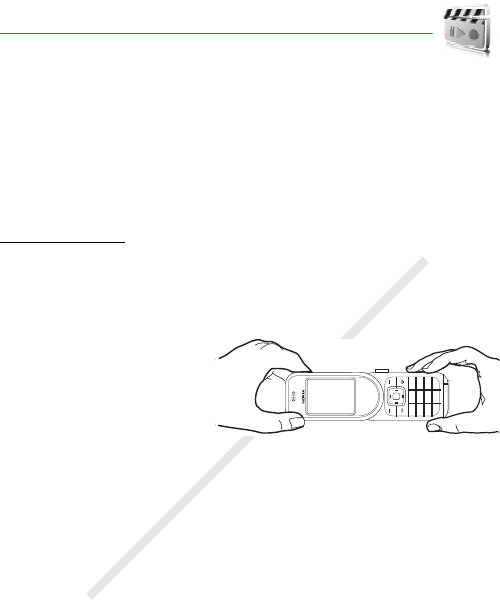
Media
61
DRAFT
12. Media
When taking and using images or video clips, obey all laws and
respect local customs as well as privacy and legitimate rights of others including
copyrights.
■Camera and video
You can take images or record video clips with the built-in camera.
Take an image
To have the still image function, press the camera key in the standby
mode, select Menu > Media > Camera, or if the video function is on,
scroll left or right.
To take an image in landscape
format, hold the phone in a
horizontal position. To zoom
in and out in the camera
mode, press the scroll key up
and down or the volume keys.
To take an image, select Capture, or press the camera key. The phone
saves the images on the memory card.
Select Options to set Night mode on if the lighting is dim, Self-timer on
to activate the self-timer, or Img. sequence on to take images in a fast
sequence. With the highest image size setting three images are taken in
a sequence; with other size settings five images are taken.
Select Options > Settings > Image preview time and a preview time to
display captured. During the preview time, select Back to take another
image or Send to send the image as a multimedia message.
Your device supports an image capture resolution of 1280 x 960 pixels. The
image resolution in these materials may appear different.
RM-209_en_1_FCC.fm Page 61 Thursday, September 7, 2006 12:18 PM

Media
62
DRAFT
Record a video clip
To have the video function, press and hold the camera key in the standby
mode, and select Menu > Media > Video or if the camera function is on,
scroll left or right. To start the video recording, select Record. To pause
the recording, select Pause; to resume the recording, select Continue; to
stop the recording, select Stop. The phone saves the video clips on the
memory card or the phone memory.
Camera and video options
To use a filter, select Options > Effects > False colours, Greyscale, Sepia,
Negative, or Solarise.
To adopt the camera to the light conditions, select Options > White
balance > Auto, Daylight, Tungsten or Fluorescent.
To change other camera and video settings and to select the image and
video storage select Options > Settings.
■Media player
With the media player you can view, play, and download files, such as
images, audio, video, and animated images. You can also view
compatible streaming videos from a network server (network service).
Select Menu > Media > Media player > Open gallery, Bookmarks, Go to
address, or Media downloads to select or download media.
Select Menu > Media > Media player > FF/Rew interval to set the step
width for fast forward or rewind.
Configuration for a streaming service
You may receive the configuration settings required for streaming as a
configuration message from the service provider. See “Configuration
settings service,” p. 10. You can also enter the settings manually. See
“Configuration,” p. 55. To activate the settings, do the following:
1. Select Menu > Media > Media player > Streaming settings >
Configuration.
2. Select a service provider, Default, or Personal config. for streaming.
RM-209_en_1_FCC.fm Page 62 Thursday, September 7, 2006 12:18 PM
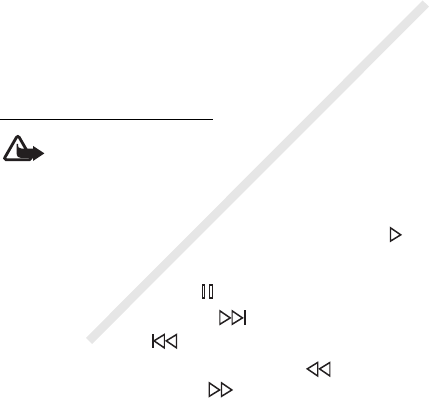
Media
63
DRAFT
3. Select Account and a streaming service account contained in the
active configuration settings.
■Music player
Your phone includes a music player for listening to music tracks or other
MP3 or AAC sound files that you have downloaded from the Web or
transferred to the phone with Nokia PC Suite. See “Nokia PC Suite,”
p. 79.
Copyright protections may prevent some images, music (including ringing tones),
and other content from being copied, modified, transferred or forwarded.
Music files stored in the music folder in the phone memory or on the
memory card will automatically be detected and added to the music
library during the startup of the phone.
To open the music player, select Menu > Media > Music player.
Playing the music tracks
Warning! Listen to music at a moderate level. Continuous exposure to
high volume may damage your hearing.
Operate the music player with the virtual keys on the display.
When you open the Music player menu, the details of the first track on
the default track list are shown. To start playing, select .
To adjust the volume level, use the volume keys on the side of the phone.
To pause the playing, select .
To skip to the next track, select . To skip to the beginning of the
previous track, select .
To rewind the current track, select and hold . To fast forward the
current track, select and hold . Release the key at the position you
want.
To stop the music player, select Back.
RM-209_en_1_FCC.fm Page 63 Thursday, September 7, 2006 12:18 PM

Media
64
DRAFT
Music player options
In the Music player menu, select from the following options:
Show tracks — View all available tracks of the active track list and play
the desired track. To play a track, scroll to the desired track, and select
Play.
Music library — View all available tracks ordered according to Artists,
Albums, Genres, Composers, or Track lists. Select Update library to
refresh the lists. Track lists generated with the Nokia Music Manager
you will find under Track lists > My track lists.
Play options — Select Random to play the tracks on the track list in
random order. Select Repeat to play the current track or the entire track
list repeatedly.
Media equaliser — to select or define an equalizer setting
Add to Favourites — to add the current track to the favorite track list
Play via Bluetooth — to connect and play the tracks on an audio
accessory using Bluetooth technology
Use tone — Set the currently played music track, for example, as a
ringing tone.
Send— to send the current track by a multimedia message or using
Bluetooth technology
Web page — to access a Web page associated with the currently played
track
Music downloads — to connect to a Web service
Memory status — to view the free and used memory capacity
■Radio
The FM radio depends on an antenna other than the wireless device’s antenna. A
compatible headset or enhancement needs to be attached to the device for the
FM radio to function properly.
Warning: Listen to music at a moderate level. Continuous exposure to
high volume may damage your hearing. Do not hold the device near
your ear when the loudspeaker is in use, because the volume may be
extremely loud.
RM-209_en_1_FCC.fm Page 64 Thursday, September 7, 2006 12:18 PM

Media
65
DRAFT
Select Menu > Media > Radio.
To use the graphical keys , , , or on the display, scroll left or
right to the desired key, and select it.
Save radio frequencies
1. To start the search, select and hold or . To change the radio
frequency in 0.05 MHz steps, briefly press or .
2. To save a frequency to a memory location, 1 to 9, press and hold the
corresponding number key. To save a frequency to a memory location
from 10 to 20, press briefly 1 or 2, and press and hold the desired
number key, 0 to 9.
3. Enter the name of the radio station.
Listen to the radio
Select Menu > Media > Radio. To scroll to the desired frequency, select
or , or press the headset key. To select a radio station, briefly
press the corresponding number keys. To adjust the volume, press the
volume keys.
Select from the following Options:
Switch off — to turn off the radio
Loudspeaker or Headset — to listen to the radio using the loudspeaker or
headset. Keep the headset connected to the phone. The lead of the
headset functions as the radio antenna.
Mono output or Stereo output — to listen to the radio in monophonic
sound or in stereo
Stations — to select the list of saved stations. To delete or rename a
station, scroll to the desired station, and select Options > Delete station
or Rename.
Search all stations — to search automatically the available stations at
your location
Set frequency — to enter the frequency of the desired radio station
Station directory — to access a Web site with a list of radio stations
RM-209_en_1_FCC.fm Page 65 Thursday, September 7, 2006 12:18 PM

Media
66
DRAFT
When an application using a packet data or HSCSD connection is
sending or receiving data, it may interfere with the radio.
■Voice recorder
You can record pieces of speech, sound, or an active call, and save them
in Gallery. This is useful when recording a name and phone number to
write down later.
The recorder cannot be used when a data call or GPRS connection is active.
Record sound
1. Select Menu > Media > Voice recorder.
To use the graphical keys , , or on the display, scroll left or
right to the desired key, and select it.
2. To start the recording, select . To start the recording during a call,
select Options > Record. While recording a call, all parties to the call
hear a faint beeping. When recording a call, hold the phone in the
normal position near to your ear. To pause the recording, select .
3. To end the recording, select . The recording is saved in Gallery >
Recordings.
To listen to the latest recording, select Options > Play last recorded.
To send the last recording, select Options > Send last recorded.
To see the list of recordings in Gallery, select Options > Recordings
list > Recordings.
■Equalizer
You can control the sound quality when using the music player by
amplifying or diminishing frequency bands.
Select Menu > Media > Equaliser.
To activate a set, scroll to one of the equalizer sets, and select Activate.
To view, edit, or rename a selected set, select Options > View, Edit, or
Rename. Not all sets can be edited or renamed.
RM-209_en_1_FCC.fm Page 66 Thursday, September 7, 2006 12:18 PM

Organizer
67
DRAFT
■Stereo widening
Stereo widening enhances the audio output of the phone by enabling a
wider stereo sound effect. To change the setting, select Menu >
Media > Stereo widening.
13. Organizer
■Alarm clock
You can set the phone to alarm at a desired time. Select Menu >
Organiser > Alarm clock.
To set the alarm, select Alarm time, and enter the alarm time. To change
the alarm time when the alarm time is set, select On.
To set the phone to alert you on selected days of the week, select Repeat
alarm.
To select the alarm tone or set the radio as the alarm tone, select Alarm
tone. If you select the radio as an alarm tone, connect the headset to the
phone.
To set a snooze time-out, select Snooze time-out and the time.
Stop the alarm
The phone sounds an alert tone, and flashes Alarm! and the current time
on the display, even if the phone was switched off. To stop the alarm,
select Stop. If you let the phone continue to sound the alarm for a
minute or select Snooze, the alarm stops for the time you set in Snooze
time-out, then resumes.
If the alarm time is reached while the device is switched off, the device switches
itself on and starts sounding the alarm tone. If you select Stop, the device asks
whether you want to activate the device for calls. Select No to switch off the
device or Yes to make and receive calls. Do not select Yes when wireless phone
use may cause interference or danger.
RM-209_en_1_FCC.fm Page 67 Thursday, September 7, 2006 12:18 PM

Organizer
68
DRAFT
■Calendar
Select Menu > Organiser > Calendar.
The current day is indicated by a frame. If there are any notes set for the
day, the day is in bold type, and the beginning of the note is shown
below the calendar. To view the day notes, select View. To view a week,
select Options > Week view. To delete all notes in the calendar, select
the month or week view, and select Options > Delete all notes.
In Settings you can set the date, time, time zone, date or time format,
date separator, default view, or the first day of the week. In Auto-delete
notes you can set the phone to delete old notes automatically after a
specified time.
Make a calendar note
Select Menu > Organiser > Calendar. Scroll to the date, and select
Options > Make a note and one of the following note types:
Meeting, Call, Birthday, Memo, or Reminder. Fill in
the fields.
Note alarm
The phone displays the note and if set, sounds a tone. With a call note
on the display, to call the displayed number, press the call key. To
stop the alarm and to view the note, select View. To stop the alarm for
10 minutes, select Snooze.
To stop the alarm without viewing the note, select Exit.
■To-do list
To save a note for a task that you must do, select Menu > Organiser >
To-do list.
To make a note if no note is added, select Add; otherwise, select
Options > Add. Fill in the fields, and select Save.
To view a note, scroll to it, and select View. While viewing a note, you
can also select an option to edit the attributes. You can also select an
RM-209_en_1_FCC.fm Page 68 Thursday, September 7, 2006 12:18 PM

Organizer
69
DRAFT
option to delete the selected note and delete all the notes that you have
marked as done.
■Notes
To write and send notes, select Menu > Organiser > Notes.
To make a note if no note is added, select Add; otherwise, select
Options > Make a note. Write the note, and select Save.
■Calculator
The calculator in your phone provides basic arithmetic and
trigonometric functions, calculates the square and the square root, the
inverse of a number, and converts currency values.
Note: This calculator has limited accuracy and is designed for simple
calculations.
Select Menu > Organiser > Calculator. Press # for a decimal point.
Scroll to the desired operation or function, or select it from the Options.
To save the exchange rate, select Options > Exchange rate.
■Countdown timer
To start the countdown timer, select Menu > Organiser > Countd.
timer > Normal timer, enter the alarm time, and write a note text that is
displayed when the time expires. To start the countdown timer, select
Start. To change the countdown time, select Change time. To stop the
timer, select Stop timer.
To have an interval timer with up to 10 intervals started, enter the
intervals. Select Menu > Organiser > Countd. timer > Interval timer. To
start the timer, select Start timer > Start.
■Stopwatch
You can measure time, take intermediate times, or take lap times using
the stopwatch. During timing, the other functions of the phone can be
used. To set the stopwatch timing in the background, press the end key.
RM-209_en_1_FCC.fm Page 69 Thursday, September 7, 2006 12:18 PM

Applications
70
DRAFT
Using the stopwatch or allowing it to run in the background when using other
features increases the demand on battery power and reduces the battery life.
Select Menu > Organiser > Stopwatch and from the following options:
Split timing — to take intermediate times. To start the time observation,
select Start. Select Split every time that you want to take an
intermediate time. To stop the time observation, select Stop.
To save the measured time, select Save.
To start the time observation again, select Options > Start. The new
time is added to the previous time. To reset the time without saving it,
select Reset.
Lap timing — to take lap times
Continue — to view the timing that you have set in the background
Show last — to view the most recently measured time if the stopwatch is
not reset
View times or Delete times — to view or delete the saved times
14. Applications
In this menu you can manage applications and games. These
files are stored in the phone memory or an attached microSD memory
card and may be arranged in folders.
For options to format or lock and unlock the memory card see “Memory
card,” p. 59.
■Launch a game
Your phone software includes some games.
Select Menu > Applications > Games. Scroll to the desired game, and
select Open.
To set sounds, lights, and shakes for the game, select Menu >
Applications > Options > Application settings. For more options, see
“Application options,” p. 71.
RM-209_en_1_FCC.fm Page 70 Thursday, September 7, 2006 12:18 PM

Applications
71
DRAFT
■Launch an application
Your phone software includes some Java applications.
Select Menu > Applications > Collection. Scroll to an application, and
select Open.
■Application options
Update version — to check if a new version of the application is available
for download from Web (network service)
Application access — to restrict the application from accessing the
network
Web page — to provide further information or additional data for the
application from an Internet page (network service), if available
■Download an application
Your phone supports J2ME Java applications. Make sure that the
application is compatible with your phone before downloading it.
Important: Only install and use applications and other software from
sources that offer adequate security and protection against harmful
software.
You can download new Java applications and games in different ways.
Use the Nokia Application Installer from PC Suite to download the
applications to your phone, or select Menu > Applications > Options >
Downloads > App. downloads; the list of available bookmarks is shown.
See “Bookmarks,” p. 73.
For the availability of different services, pricing, and tariffs, contact your
service provider.
Your device may have some bookmarks loaded for sites not affiliated with Nokia.
Nokia does not warrant or endorse these sites. If you choose to access them, you
should take the same precautions, for security or content, as you would with any
Internet site.
RM-209_en_1_FCC.fm Page 71 Thursday, September 7, 2006 12:18 PM

Web
72
DRAFT
15. Web
You can access various mobile Internet services with your
phone browser.
Important: Use only services that you trust and that offer adequate
security and protection against harmful software.
Check the availability of these services, pricing, tariffs, and instructions
with your service provider.
With the phone browser you can view the services that use wireless
markup language (WML) or extensible hypertext markup language
(XHTML) on their pages. Appearance may vary due to screen size. You
may not be able to view all details of the Internet pages.
■Set up browsing
You may receive the configuration settings required for browsing as a
configuration message from the service provider that offers the service
that you want to use. See “Configuration settings service,” p. 10. You
can also enter all the configuration settings manually. See
“Configuration,” p. 55.
■Connect to a service
Ensure that the correct configuration settings of the service are
activated.
1. To select the settings for connecting to the service, select Menu >
Web > Settings > Configuration sett..
2. Select Configuration. Only the configurations that support browsing
service are shown. Select a service provider, Default, or Personal
config. for browsing. See “Set up browsing,” p. 72.
3. Select Account and a browsing service account contained in the
active configuration settings.
4. Select Displ. term. window > Yes to perform manual user
authentication for intranet connections.
RM-209_en_1_FCC.fm Page 72 Thursday, September 7, 2006 12:18 PM

Web
73
DRAFT
Make a connection to the service in one of the following ways:
•Select Menu > Web > Home.
• To select a bookmark of the service, select Menu > Web >
Bookmarks.
• To select the last URL, select Menu > Web > Last web addr..
• To enter the address of the service, select Menu > Web > Go to
address. Enter the address of the service, and select OK.
■Browse pages
After you make a connection to the service, you can start browsing its
pages. The function of the phone keys may vary in different services.
Follow the text guides on the phone display. For more information,
contact your service provider.
Browse with phone keys
To browse through the page, scroll in any direction.
To select an item, press the call key, or select Select.
To enter letters and numbers, press the 0 to 9 keys. To enter special
characters, press *.
Direct calling
While browsing, you can make a phone call, and save a name and a
phone number from a page.
■Bookmarks
You can save page addresses as bookmarks in the phone memory.
1. While browsing, select Options > Bookmarks; or in the standby
mode, select Menu > Web > Bookmarks.
2. Scroll to a bookmark, and select it; or press the call key to make a
connection to the page associated with the bookmark.
3. Select Options to view, edit, delete, or send the bookmark; to create
a new bookmark; or to save the bookmark to a folder.
RM-209_en_1_FCC.fm Page 73 Thursday, September 7, 2006 12:18 PM

Web
74
DRAFT
Your device may have some bookmarks loaded for sites not affiliated with Nokia.
Nokia does not warrant or endorse these sites. If you choose to access them, you
should take the same precautions, for security or content, as you would with any
Internet site.
Receive a bookmark
When you have received a bookmark that is sent as a bookmark, 1
bookmark received is displayed. To view the bookmark, select Show.
■Appearance settings
While browsing, select Options > Other options > Appearance settings;
or in the standby mode, select Menu > Web > Settings > Appearance
settings and from the following options:
Text wrapping — to select how the text shall appear on the display
Font size — to set the font size
Show images > No — to hide images on the page
Alerts > Alert for unsec. conn. > Yes — to set the phone to alert when a
secure connection changes to an unsecure one during browsing
Alerts > Alert for unsec. items > Yes — to set the phone to alert when a
secure page contains an unsecure item. These alerts do not guarantee a
secure connection. For more information, see “Browser security,” p. 76.
Character encoding > Content encoding — to select the encoding for the
browser page content
Character encoding > Unicode (UTF-8) addr. > On — to set the phone to
send a URL as a UTF-8 encoding
Screen size > Full or Small— to set the screen layout
JavaScript > Enable — to enable the Java scripts
RM-209_en_1_FCC.fm Page 74 Thursday, September 7, 2006 12:18 PM

Web
75
DRAFT
■Security settings
Cookies
A cookie is data that a site saves in the cache memory of your phone.
Cookies are saved until you clear the cache memory. See “Cache
memory,” p. 76.
While browsing, select Options > Other options > Security > Cookie
settings; or in the standby mode, select Menu > Web > Settings >
Security settings > Cookies. To allow or prevent the phone from
receiving cookies, select Allow or Reject.
Scripts over secure connection
You can select whether to allow the running of scripts from a secure
page. The phone supports WML scripts.
While browsing, to allow the scripts, select Options > Other options >
Security > WMLScript settings; or in the standby mode, select Menu >
Web > Settings > Security settings > WMLScripts in conn. > Allow.
■Download settings
To automatically save all downloaded files in Gallery, select Menu >
Web > Settings > Downloading sett. > Automatic saving > On.
■Service inbox
The phone is able to receive service messages sent by your service
provider (network service). Service messages are notifications (for
example, news headlines), and they may contain a text message or an
address of a service.
To access the Service inbox in the standby mode, when you have
received a service message, select Show. If you select Exit, the message
is moved to the Service inbox. To access the Service inbox later, select
Menu > Web > Service inbox.
To access the Service inbox while browsing, select Options > Other
options > Service inbox. Scroll to the message you want, and to activate
RM-209_en_1_FCC.fm Page 75 Thursday, September 7, 2006 12:18 PM

Web
76
DRAFT
the browser and download the marked content, select Retrieve. To
display detailed information on the service notification or delete the
message, select Options > Details or Delete.
Service inbox settings
Select Menu > Web > Settings > Service inbox sett..
To set whether you want to receive service messages, select Service
messages > On or Off.
To set the phone to receive service messages only from content authors
approved by the service provider, select Message filter > On. To view the
list of the approved content authors, select Trusted channels.
To set the phone to automatically activate the browser from the standby
mode when the phone has received a service message, select Autom.
connection > On. If you select Off, the phone activates the browser only
after you select Retrieve when the phone has received a service
message.
■Cache memory
A cache is a memory location that is used to store data temporarily. If you have
tried to access or have accessed confidential information requiring passwords,
empty the cache after each use. The information or services you have accessed is
stored in the cache.
To empty the cache while browsing, select Options > Other options >
Clear the cache; in the standby mode, select Menu > Web > Clear the
cache.
■Browser security
Security features may be required for some services, such as online
banking or shopping. For such connections you need security
certificates and possibly a security module, which may be available on
your SIM card. For more information, contact your service provider.
RM-209_en_1_FCC.fm Page 76 Thursday, September 7, 2006 12:18 PM

Web
77
DRAFT
Security module
The security module improves security services for applications
requiring a browser connection, and allows you to use a digital
signature. The security module may contain certificates as well as
private and public keys. The certificates are saved in the security module
by the service provider.
To view or change the security module settings, select Menu >
Settings > Security > Security module sett..
Certificates
Important: Even if the use of certificates makes the risks involved in
remote connections and software installation considerably smaller,
they must be used correctly in order to benefit from increased security.
The existence of a certificate does not offer any protection by itself; the
certificate manager must contain correct, authentic, or trusted certificates for
increased security to be available. Certificates have a restricted lifetime. If
Expired certificate or Certificate not valid yet is shown even if the certificate
should be valid, check that the current date and time in your device are correct.
Before changing any certificate settings, you must make sure that you really trust
the owner of the certificate and that the certificate really belongs to the listed
owner.
There are three kinds of certificates: server certificates, authority
certificates, and user certificates. You may receive these certificates
from your service provider. Authority certificates and user certificates
may also be saved in the security module by the service provider.
To view the list of the authority or user certificates downloaded into
your phone, select Menu > Settings > Security > Authority certificates
or User certificates.
is displayed during a connection, if the data transmission between
the phone and the content server is encrypted.
The security icon does not indicate that the data transmission between the
gateway and the content server (or place where the requested resource is stored)
is secure. The service provider secures the data transmission between the
gateway and the content server.
RM-209_en_1_FCC.fm Page 77 Thursday, September 7, 2006 12:18 PM
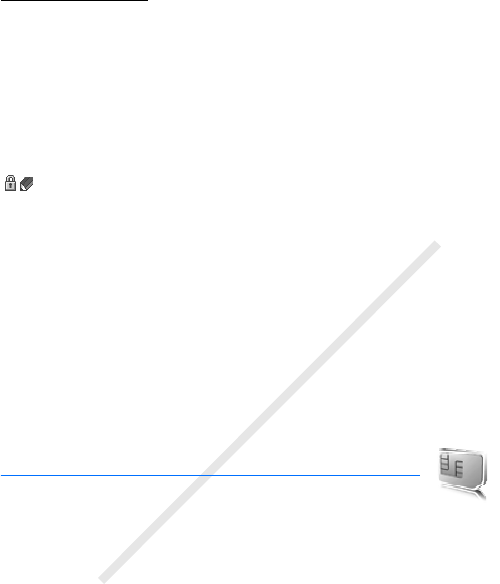
SIM services
78
DRAFT
Digital signature
You can make digital signatures with your phone if your SIM card has a
security module. Using the digital signature can be the same as signing
your name to a paper bill, contract, or other document.
To make a digital signature, select a link on a page (for example, the title
of the book you want to buy and its price). The text to sign is shown,
which may include the amount and date.
Check that the header text is Read and that the digital signature icon
is shown.
If the digital signature icon does not appear, there is a security breach,
and you should not enter any personal data such as your signing PIN.
To sign the text, read all of the text first, and select Sign.
The text may not fit within a single screen. Therefore, make sure to scroll
through and read all of the text before signing.
Select the user certificate you want to use. Enter the signing PIN. The
digital signature icon disappears, and the service may display a
confirmation of your purchase.
16. SIM services
Your SIM card may provide additional services. You can
access this menu only if it is supported by your SIM card. The name and
contents of the menu depend on the available services.
For availability and information on using SIM card services, contact your SIM
card vendor. This may be the service provider, network operator, or other vendor.
To set the phone to show you the confirmation messages sent between
your phone and the network when you are using the SIM services, select
Menu > Settings > Phone > Confirm SIM actions > Yes.
Accessing these services may involve sending messages or making a
phone call for which you may be charged.
RM-209_en_1_FCC.fm Page 78 Thursday, September 7, 2006 12:18 PM

PC connectivity
79
DRAFT
17. PC connectivity
You can send and receive e-mail, and access the Internet when your
phone is connected to a compatible PC through a Bluetooth or a data
cable connection. You can use your phone with a variety of PC
connectivity and data communications applications.
■Nokia PC Suite
With Nokia PC Suite you can synchronize contacts, calendar, notes, and
to-do notes between your phone and the compatible PC or a remote
Internet server (network service). You may find more information and PC
Suite on the Nokia Web site at www.nokia.com/support or your local
Nokia Web site.
■Packet data, HSCSD, and CSD
With your phone you can use the packet data, high-speed circuit
switched data (HSCSD), and circuit switched data (CSD, GSM data) data
services. For availability and subscription to data services, contact your
network operator or service provider. See “Modem settings,” p. 50.
The use of HSCSD services consumes the phone battery faster than
normal voice or data calls.
■Bluetooth
Use the Bluetooth technology to connect your compatible Laptop to the
Internet. Your phone must have activated a service provider that
supports Internet access and your PC has to support Bluetooth PAN
(Personal Area Network). After connecting to the network access point
(NAP) service of the phone and pairing with your PC your phone
automatically opens a packet data connection to the Internet. PC Suite
software installation is not necessary when using the NAP service of the
phone.
See “Bluetooth wireless technology,” p. 49.
RM-209_en_1_FCC.fm Page 79 Thursday, September 7, 2006 12:18 PM

Battery information
80
DRAFT
■Data communication applications
For information on using a data communication application, refer to the
documentation provided with it.
Making or answering phone calls during a computer connection is not
recommended, as it might disrupt the operation.
For better performance during data calls, place the phone on a
stationary surface with the keypad facing downward. Do not move the
phone by holding it in your hand during a data call.
18. Battery information
■Charging and discharging
Your device is powered by a rechargeable battery. The full performance of a new
battery is achieved only after two or three complete charge and discharge cycles.
The battery can be charged and discharged hundreds of times, but it will
eventually wear out. When the talk and standby times are noticeably shorter
than normal, replace the battery. Use only Nokia approved batteries, and
recharge your battery only with Nokia approved chargers designated for this
device.
If a replacement battery is being used for the first time or if the battery has not
been used for a prolonged period, it may be necessary to connect the charger and
then disconnect and reconnect it to start the charging.
Unplug the charger from the electrical plug and the device when not in use. Do
not leave fully charged battery connected to a charger, since overcharging may
shorten its lifetime. If left unused, a fully charged battery will lose its charge over
time.
If the battery is completely discharged, it may take a few minutes before the
charging indicator appears on the display or before any calls can be made.
Use the battery only for its intended purpose. Never use any charger or battery
that is damaged.
Do not short-circuit the battery. Accidental short-circuiting can occur when a
metallic object such as a coin, clip, or pen causes direct connection of the
positive (+) and negative (-) terminals of the battery. (These look like metal strips
on the battery.) This might happen, for example, when you carry a spare battery
RM-209_en_1_FCC.fm Page 80 Thursday, September 7, 2006 12:18 PM
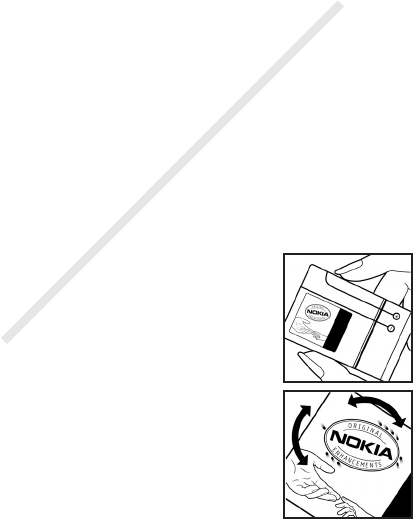
Battery information
81
DRAFT
in your pocket or purse. Short-circuiting the terminals may damage the battery
or the connecting object.
Leaving the battery in hot or cold places, such as in a closed car in summer or
winter conditions, will reduce the capacity and lifetime of the battery. Always try
to keep the battery between 15°C and 25°C (59°F and 77°F). A device with a hot
or cold battery may not work temporarily, even when the battery is fully charged.
Battery performance is particularly limited in temperatures well below freezing.
Do not dispose of batteries in a fire as they may explode. Batteries may also
explode if damaged. Dispose of batteries according to local regulations. Please
recycle when possible. Do not dispose as household waste.
■Nokia battery authentication
Always use original Nokia batteries for your safety. To check that you are getting
an original Nokia battery, purchase it from an authorized Nokia dealer, look for
the Nokia Original Enhancements logo on the packaging, and inspect the
hologram label using the following steps:
Successful completion of the four steps is not a total assurance of the
authenticity of the battery. If you have any reason to believe that your battery is
not an authentic original Nokia battery, you should refrain from using it, and take
it to the nearest authorized Nokia service point or dealer for assistance. Your
authorized Nokia service point or dealer will inspect the battery for authenticity.
If authenticity cannot be verified, return the battery to the place of purchase.
Authenticate hologram
1. When looking at the hologram on the label, you
should see the Nokia connecting hands symbol from
one angle and the Nokia Original Enhancements
logo when looking from another angle.
2. When you angle the hologram left, right, down, and
up, you should see 1, 2, 3, and 4 dots on each side
respectively.
RM-209_en_1_FCC.fm Page 81 Thursday, September 7, 2006 12:18 PM
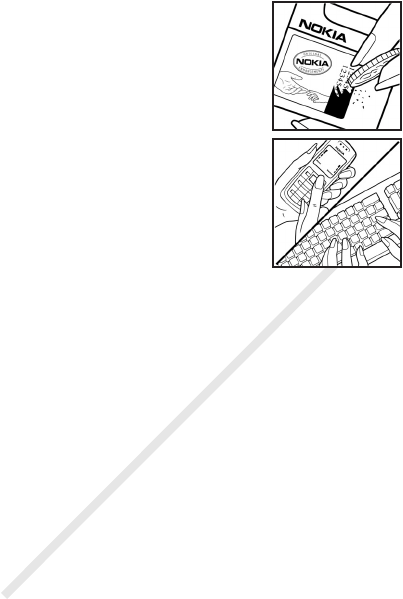
Battery information
82
DRAFT
3. Scratch the side of the label to reveal a 20-digit
code, for example, 12345678919876543210. Turn
the battery so that the numbers are facing upwards.
The 20-digit code reads starting from the number at
the top row followed by the bottom row.
4. Confirm that the 20-digit code is valid by following
the instructions at www.nokia.com/batterycheck.
To create a text message enter the 20-digit code, for
example, 12345678919876543210, and send to +44
7786 200276.
To create a text message,
• For countries in Asia Pacific, excluding India: Enter the 20-digit code, for
example, 12345678919876543210, and send to +61 427151515.
• For India only: Enter Battery followed by the 20-digit battery code, for
example, Battery 12345678919876543210, and send to 5555.
National and international operator charges will apply.
You should receive a message indicating whether the code can be authenticated.
What if your battery is not authentic?
If you cannot confirm that your Nokia battery with the hologram on the label is
an authentic Nokia battery, please do not use the battery. Take it to the nearest
authorized Nokia service point or dealer for assistance. The use of a battery that
is not approved by the manufacturer may be dangerous and may result in poor
performance and damage to your device and its enhancements. It may also
invalidate any approval or warranty applying to the device.
To find out more about original Nokia batteries, visit www.nokia.com/battery.
RM-209_en_1_FCC.fm Page 82 Thursday, September 7, 2006 12:18 PM

Technical Information
83
DRAFT
19. Technical Information
Weight 104 grams (3.7 ounces) incl. BL-4B battery
Battery 820 mAh Li-Ion Battery
Networks Wireless networks GSM 900,
1800 and 1900
Size Volume: 4.6 cubic inches (75 ccm)
Length: 3.5 in (88 mm)
Width: 1.7 in (43 mm)
Thickness: 0.9 in (23 mm)
Frequency range (Rx) GSM 900: 925 - 960 MHz
GSM1800: 1805 - 1880 MHz
GSM1900: 1930 - 1990 MHz
Frequency range (Tx) GSM 900: 880 - 915 MHz
GSM 1800: 1710 - 1785 MHz
GSM1900: 1850 - 1910 MHz
Tx output power 2 W (max)
Battery voltage 3.7 V DC
Number of channels GSM 900: 174
GSM 1800: 374
GSM 1900: 299
Memory size 32 MB flash memory
16 MB RAM
Operating temperature 59 °F to 77 °F
(15 °C to 25 °C)
RM-209_en_1_FCC.fm Page 83 Thursday, September 7, 2006 12:18 PM

Care and maintenance
84
DRAFT
Care and maintenance
Your device is a product of superior design and craftsmanship and should be
treated with care. The suggestions below will help you protect your warranty
coverage.
• Keep the device dry. Precipitation, humidity and all types of liquids or
moisture can contain minerals that will corrode electronic circuits. If your
device does get wet, remove the battery and allow the device to dry
completely before replacing it.
• Do not use or store the device in dusty, dirty areas. Its moving parts and
electronic components can be damaged.
• Do not store the device in hot areas. High temperatures can shorten the life of
electronic devices, damage batteries, and warp or melt certain plastics.
• Do not store the device in cold areas. When the device returns to its normal
temperature, moisture can form inside the device and damage electronic
circuit boards.
• Do not attempt to open the device other than as instructed in this guide.
• Do not drop, knock, or shake the device. Rough handling can break internal
circuit boards and fine mechanics.
• Do not use harsh chemicals, cleaning solvents, or strong detergents to clean
the device.
• Do not paint the device. Paint can clog the moving parts and prevent proper
operation.
• Do not touch the main display with hard or angular materials. Objects like
earrings or jewellery may scratch the display.
• Use a soft, clean, dry cloth to clean any lenses (such as camera, proximity
sensor, and light sensor lenses).
• Use only the supplied or an approved replacement antenna. Unauthorized
antennas, modifications, or attachments could damage the device and may
violate regulations governing radio devices.
• Use chargers indoors.
• Always create a backup of data you want to keep (such as contacts and
calendar notes) before sending your device to a service facility.
All of the above suggestions apply equally to your device, battery, charger, or any
enhancement. If any device is not working properly, take it to the nearest
authorized service facility for service.
RM-209_en_1_FCC.fm Page 84 Thursday, September 7, 2006 12:18 PM

Additional safety information
85
DRAFT
Additional safety information
Your device and its enhancements may contain small parts. Keep them out of the
reach of small children.
■Operating environment
Remember to follow any special regulations in force in any area, and always
switch off your device when its use is prohibited or when it may cause
interference or danger. Use the device only in its normal operating positions. This
device meets RF exposure guidelines when used either in the normal use position
against the ear or when positioned at least 2.2 centimeters (7/8 inch) away from
the body. When a carry case, belt clip or holder is used for body-worn operation,
it should not contain metal and should position the device the above-stated
distance from your body.
To transmit data files or messages, this device requires a quality connection to
the network. In some cases, transmission of data files or messages may be
delayed until such a connection is available. Ensure that the above separation
distance instructions are followed until the transmission is completed.
Parts of the device are magnetic. Metallic materials may be attracted to the
device. Do not place credit cards or other magnetic storage media near the
device, because information stored on them may be erased.
■Medical devices
Operation of any radio transmitting equipment, including wireless phones, may
interfere with the functionality of inadequately protected medical devices.
Consult a physician or the manufacturer of the medical device to determine if
they are adequately shielded from external RF energy or if you have any
questions. Switch off your device in health care facilities when any regulations
posted in these areas instruct you to do so. Hospitals or health care facilities may
be using equipment that could be sensitive to external RF energy.
Pacemakers
Pacemaker manufacturers recommend that a minimum separation of
15.3 centimeters (6 inches) be maintained between a wireless phone and a
pacemaker to avoid potential interference with the pacemaker. These
recommendations are consistent with the independent research by and
recommendations of Wireless Technology Research. Persons with pacemakers
should do the following:
RM-209_en_1_FCC.fm Page 85 Thursday, September 7, 2006 12:18 PM

Additional safety information
86
DRAFT
• Always keep the device more than 15.3 centimeters (6 inches) from the
pacemaker
• Not carry the device in a breast pocket
• Hold the device to the ear opposite the pacemaker to minimize the potential
for interference.
If you suspect interference, switch off your device, and move the device away.
Hearing aids
Some digital wireless devices may interfere with some hearing aids. If
interference occurs, consult your service provider.
■Vehicles
RF signals may affect improperly installed or inadequately shielded electronic
systems in motor vehicles such as electronic fuel injection systems, electronic
antiskid (antilock) braking systems, electronic speed control systems, and air bag
systems. For more information, check with the manufacturer or its representative
of your vehicle or any equipment that has been added.
Only qualified personnel should service the device, or install the device in a
vehicle. Faulty installation or service may be dangerous and may invalidate any
warranty that may apply to the device. Check regularly that all wireless device
equipment in your vehicle is mounted and operating properly. Do not store or
carry flammable liquids, gases, or explosive materials in the same compartment
as the device, its parts, or enhancements. For vehicles equipped with an air bag,
remember that air bags inflate with great force. Do not place objects, including
installed or portable wireless equipment in the area over the air bag or in the air
bag deployment area. If in-vehicle wireless equipment is improperly installed and
the air bag inflates, serious injury could result.
Using your device while flying in aircraft is prohibited. Switch off your device
before boarding an aircraft. The use of wireless teledevices in an aircraft may be
dangerous to the operation of the aircraft, disrupt the wireless telephone
network, and may be illegal.
■Potentially explosive environments
Switch off your device when in any area with a potentially explosive atmosphere
and obey all signs and instructions. Potentially explosive atmospheres include
areas where you would normally be advised to turn off your vehicle engine.
Sparks in such areas could cause an explosion or fire resulting in bodily injury or
even death. Switch off the device at refueling points such as near gas pumps at
service stations. Observe restrictions on the use of radio equipment in fuel
RM-209_en_1_FCC.fm Page 86 Thursday, September 7, 2006 12:18 PM

Additional safety information
87
DRAFT
depots, storage, and distribution areas; chemical plants; or where blasting
operations are in progress. Areas with a potentially explosive atmosphere are
often but not always clearly marked. They include below deck on boats, chemical
transfer or storage facilities, vehicles using liquefied petroleum gas (such as
propane or butane), and areas where the air contains chemicals or particles such
as grain, dust, or metal powders.
■Emergency calls
Important: Wireless phones, including this device, operate using radio
signals, wireless networks, landline networks, and user-programmed
functions. Because of this, connections in all conditions cannot be
guaranteed. You should never rely solely on any wireless device for
essential communications like medical emergencies.
To make an emergency call:
1. If the device is not on, switch it on. Check for adequate signal strength.
Some networks may require that a valid SIM card is properly inserted in the
device.
2. Press the end key as many times as needed to clear the display and ready the
device for calls.
3. Enter the official emergency number for your present location. Emergency
numbers vary by location.
4. Press the call key.
If certain features are in use, you may first need to turn those features off before
you can make an emergency call. If the device is in the offline or flight mode, you
must change the profile to activate the phone function before you can make an
emergency call. Consult this guide or your service provider for more information.
When making an emergency call, give all the necessary information as accurately
as possible. Your wireless device may be the only means of communication at the
scene of an accident. Do not end the call until given permission to do so.
■Certification information (SAR)
THIS MOBILE DEVICE MEETS GUIDELINES FOR EXPOSURE TO RADIO WAVES.
Your mobile device is a radio transmitter and receiver. It is designed not to
exceed the limits for exposure to radio waves recommended by international
guidelines. These guidelines were developed by the independent scientific
organization ICNIRP and include safety margins designed to assure the
protection of all persons, regardless of age and health.
RM-209_en_1_FCC.fm Page 87 Thursday, September 7, 2006 12:18 PM

Additional safety information
88
DRAFT
The exposure guidelines for mobile devices employ a unit of measurement known
as the Specific Absorption Rate or SAR. The SAR limit stated in the ICNIRP
guidelines is 2.0 watts/kilogram (W/kg) averaged over 10 grams of tissue. Tests
for SAR are conducted using standard operating positions with the device
transmitting at its highest certified power level in all tested frequency bands. The
actual SAR level of an operating device can be below the maximum value
because the device is designed to use only the power required to reach the
network. That amount changes depending on a number of factors such as how
close you are to a network base station. The highest SAR value under the ICNIRP
guidelines for use of the device at the ear is 0.73 W/kg.
Use of device accessories and enhancements may result in different SAR values.
SAR values may vary depending on national reporting and testing requirements
and the network band. Additional SAR information may be provided under
product information at www.nokia.com.
Your mobile device is also designed to meet the requirements for exposure to
radio waves established by the Federal Communications Commission (USA) and
Industry Canada. These requirements set a SAR limit of 1.6 W/kg averaged over 1
gram of tissue. The highest SAR value reported under this standard during
product certification for use at the ear is 0.56 W/kg and when properly worn on
the body is 0.47 W/kg. Information about this device model can be found at
http://www.fcc.gov/oet/fccid by searching the equipment authorization system
using FCC ID: PPIRM-209.
RM-209_en_1_FCC.fm Page 88 Thursday, September 7, 2006 12:18 PM

APPENDIX
89
DRAFT
APPENDIX
■A message from the CTIA
© 2001 Cellular Telecommunications & Internet Association. All Rights Reserved.
1250 Connecticut Avenue, NW Suite 800, Washington, DC 20036. Phone: (202)
785-0081
Safety is the most important call you will ever make.
A Guide to Safe and Responsible Wireless Phone Use
Tens of millions of people in the U.S. today take advantage of the unique
combination of convenience, safety and value delivered by the wireless
telephone. Quite simply, the wireless phone gives people the powerful ability to
communicate by voice--almost anywhere, anytime--with the boss, with a client,
with the kids, with emergency personnel or even with the police. Each year,
Americans make billions of calls from their wireless phones, and the numbers are
rapidly growing.
But an important responsibility accompanies those benefits, one that every
wireless phone user must uphold. When driving a car, driving is your first
responsibility. A wireless phone can be an invaluable tool, but good judgment
must be exercised at all times while driving a motor vehicle--whether on the
phone or not.
The basic lessons are ones we all learned as teenagers. Driving requires alertness,
caution and courtesy. It requires a heavy dose of basic common sense---keep
your head up, keep your eyes on the road, check your mirrors frequently and
watch out for other drivers. It requires obeying all traffic signs and signals and
staying within the speed limit. It means using seatbelts and requiring other
passengers to do the same.
But with wireless phone use, driving safely means a little more. This brochure is a
call to wireless phone users everywhere to make safety their first priority when
behind the wheel of a car. Wireless telecommunications is keeping us in touch,
simplifying our lives, protecting us in emergencies and providing opportunities to
help others in need.
When it comes to the use of wireless phones, safety is your most important call.
Wireless phone "Safety Tips"
1. Get to know your wireless phone and its features such as speed dial and
redial. Carefully read your instruction manual and learn to take advantage of
valuable features most phones offer, including automatic redial and memory.
RM-209_en_1_FCC.fm Page 89 Thursday, September 7, 2006 12:18 PM

APPENDIX
90
DRAFT
Also, work to memorize the phone keypad so you can use the speed dial
function without taking your attention off the road.
2. When available, use a hands free device. A number of hands free wireless
phone accessories are readily available today. Whether you choose an
installed mounted device for your wireless phone or a speaker phone
accessory, take advantage of these devices if available to you.
3. Position your wireless phone within easy reach. Make sure you place your
wireless phone within easy reach and where you can grab it without
removing your eyes from the road. If you get an incoming call at an
inconvenient time, if possible, let your voice mail answer it for you.
4. .Suspend conversations during hazardous driving conditions or situations. Let
the person you are speaking with know you are driving; if necessary, suspend
the call in heavy traffic or hazardous weather conditions. Rain, sleet, snow
and ice can be hazardous, but so is heavy traffic. As a driver, your first
responsibility is to pay attention to the road.
5. Do not take notes or look up phone numbers while driving. If you are reading
an address book or business card, or writing a “to do” list while driving a car,
you are not watching where you are going. It’s common sense. Don’t get
caught in a dangerous situation because you are reading or writing and not
paying attention to the road or nearby vehicles.
6. Dial sensibly and assess the traffic; if possible, place calls when you are not
moving or before pulling into traffic. Try to plan your calls before you begin
your trip or attempt to coincide your calls with times you may be stopped at a
stop sign, red light or otherwise stationary. But if you need to dial while
driving, follow this simple tip--dial only a few numbers, check the road and
your mirrors, then continue.
7. Do not engage in stressful or emotional conversations that may be
distracting. Stressful or emotional conversations and driving do not mix--
they are distracting and even dangerous when you are behind the wheel of a
car. Make people you are talking with aware you are driving and if necessary,
suspend conversations which have the potential to divert your attention from
the road.
8. Use your wireless phone to help others in emergencies. Your wireless phone
provides you a perfect opportunity to be a “Good Samaritan” in your
community. If you see an auto accident, crime in progress or other serious
emergency where lives are in danger, call 9-1-1 or other local emergency
number, as you would want others to do for you.
RM-209_en_1_FCC.fm Page 90 Thursday, September 7, 2006 12:18 PM

APPENDIX
91
DRAFT
9. Use your wireless phone to call for help. Your wireless phone is one of the
greatest tools you can own to protect yourself and your family in dangerous
situations--with your phone at your side, help is only three numbers away.
Dial 9-1-1 or other local emergency number in the case of fire, traffic
accident, road hazard or medical emergency. Remember, it is a free call on
your wireless phone!
10. Use your wireless phone to help others in emergencies. Your wireless phone
provides you a perfect opportunity to be a “Good Samaritan” in your
community. If you see an auto accident, crime in progress or other serious
emergency where lives are in danger, call 9-1-1 or other local emergency
number, as you would want others to do for you.
11. Call roadside assistance or a special wireless non-emergency assistance
number when necessary. Certain situations you encounter while driving may
require attention, but are not urgent enough to merit a call for emergency
services. But you still can use your wireless phone to lend a hand. If you see a
broken-down vehicle posing no serious hazard, a broken traffic signal, a
minor traffic accident where no one appears injured or a vehicle you know to
be stolen, call roadside assistance or other special non-emergency wireless
number.
Careless, distracted individuals and people driving irresponsibly represent a
hazard to everyone on the road. Since 1984, the Cellular Telecommunications
Industry Association and the wireless industry have conducted educational
outreach to inform wireless phone users of their responsibilities as safe drivers
and good citizens. As we approach a new century, more and more of us will take
advantage of the benefits of wireless telephones. And, as we take to the roads,
we all have a responsibility to drive safely.
The wireless industry reminds you to use your phone safely when driving.
For more information, please call 1-888-901-SAFE.
For updates: http://www.wow-com.com/consumer/issues/driving/
articles.cfm?ID=85
■Message from the FDA
The U.S. Food and Drug Administration (FDA) provides the following consumer
information about wireless phones.
See http://www.fda.gov/cellphones/ for updated information.
Do wireless phones pose a health hazard?
The available scientific evidence does not show that any health problems are
associated with using wireless phones. There is no proof, however, that wireless
RM-209_en_1_FCC.fm Page 91 Thursday, September 7, 2006 12:18 PM

APPENDIX
92
DRAFT
phones are absolutely safe. Wireless phones emit low levels of radiofrequency
energy (RF) in the microwave range while being used. They also emit very low
levels of RF when in the stand-by mode. Whereas high levels of RF can produce
health effects (by heating tissue), exposure to low level RF that does not produce
heating effects causes no known adverse health effects. Many studies of low
level RF exposures have not found any biological effects. Some studies have
suggested that some biological effects may occur, but such findings have not
been confirmed by additional research. In some cases, other researchers have had
difficulty in reproducing those studies, or in determining the reasons for
inconsistent results.
What is FDA's role concerning the safety of wireless phones?
Under the law, FDA does not review the safety of radiation-emitting consumer
products such as wireless phones before they can be sold, as it does with new
drugs or medical devices. However, the agency has authority to take action if
wireless phones are shown to emit radiofrequency energy (RF) at a level that is
hazardous to the user. In such a case, FDA could require the manufacturers of
wireless phones to notify users of the health hazard and to repair, replace or
recall the phones so that the hazard no longer exists.
Although the existing scientific data do not justify FDA regulatory actions, FDA
has urged the wireless phone industry to take a number of steps, including the
following:
• Support needed research into possible biological effects of RF of the type
emitted by wireless phones;
• Design wireless phones in a way that minimizes any RF exposure to the user
that is not necessary for device function; and
• Cooperate in providing users of wireless phones with the best possible
information on possible effects of wireless phone use on human health.
FDA belongs to an interagency working group of the federal agencies that have
responsibility for different aspects of RF safety to ensure coordinated efforts at
the federal level. The following agencies belong to this working group:
• National Institute for Occupational Safety and Health
• Environmental Protection Agency
• Federal Communications Commission
• Occupational Safety and Health Administration
• National Telecommunications and Information Administration
The National Institutes of Health participates in some interagency working group
activities, as well.
RM-209_en_1_FCC.fm Page 92 Thursday, September 7, 2006 12:18 PM

APPENDIX
93
DRAFT
FDA shares regulatory responsibilities for wireless phones with the Federal
Communications Commission (FCC). All phones that are sold in the United States
must comply with FCC safety guidelines that limit RF exposure. FCC relies on FDA
and other health agencies for safety questions about wireless phones.
FCC also regulates the base stations that the wireless phone networks rely upon.
While these base stations operate at higher power than do the wireless phones
themselves, the RF exposures that people get from these base stations are
typically thousands of times lower than those they can get from wireless phones.
Base stations are thus not the primary subject of the safety questions discussed
in this document.
What is FDA doing to find out more about the possible health effects of
wireless phone RF?
FDA is working with the U.S. National Toxicology Program and with groups of
investigators around the world to ensure that high priority animal studies are
conducted to address important questions about the effects of exposure to
radiofrequency energy (RF). FDA has been a leading participant in the World
Health Organization International Electromagnetic Fields (EMF) Project since its
inception in 1996. An influential result of this work has been the development of
a detailed agenda of research needs that has driven the establishment of new
research programs around the world. The Project has also helped develop a series
of public information documents on EMF issues. FDA and the Cellular
Telecommunications & Internet Association (CTIA) have a formal Cooperative
Research and Development Agreement (CRADA) to do research on wireless phone
safety. FDA provides the scientific oversight, obtaining input from experts in
government, industry, and academic organizations. CTIA-funded research is
conducted through contracts to independent investigators. The initial research
will include both laboratory studies and studies of wireless phone users. The
CRADA will also include a broad assessment of additional research needs in the
context of the latest research developments around the world.
What steps can I take to reduce my exposure to radiofrequency energy from
my wireless phone?
If there is a risk from these products--and at this point we do not know that there
is--it is probably very small. But if you are concerned about avoiding even
potential risks, you can take a few simple steps to minimize your exposure to
radiofrequency energy (RF). Since time is a key factor in how much exposure a
person receives, reducing the amount of time spent using a wireless phone will
reduce RF exposure.
If you must conduct extended conversations by wireless phone every day, you
could place more distance between your body and the source of the RF, since the
RM-209_en_1_FCC.fm Page 93 Thursday, September 7, 2006 12:18 PM

APPENDIX
94
DRAFT
exposure level drops off dramatically with distance. For example, you could use a
headset and carry the wireless phone away from your body or use a wireless
phone connected to a remote antenna
Again, the scientific data do not demonstrate that wireless phones are harmful.
But if you are concerned about the RF exposure from these products, you can use
measures like those described above to reduce your RF exposure from wireless
phone use.
What about children using wireless phones?
The scientific evidence does not show a danger to users of wireless phones,
including children and teenagers. If you want to take steps to lower exposure to
radiofrequency energy (RF), the measures described above would apply to
children and teenagers using wireless phones. Reducing the time of wireless
phone use and increasing the distance between the user and the RF source will
reduce RF exposure. Some groups sponsored by other national governments have
advised that children be discouraged from using wireless phones at all. For
example, the government in the United Kingdom distributed leaflets containing
such a recommendation in December 2000. They noted that no evidence exists
that using a wireless phone causes brain tumors or other ill effects. Their
recommendation to limit wireless phone use by children was strictly
precautionary; it was not based on scientific evidence that any health hazard
exists.
Do hands-free kits for wireless phones reduce risks from exposure to RF
emissions?
Since there are no known risks from exposure to RF emissions from wireless
phones, there is no reason to believe that hands-free kits reduce risks. Hands-free
kits can be used with wireless phones for convenience and comfort. These
systems reduce the absorption of RF energy in the head because the phone,
which is the source of the RF emissions, will not be placed against the head. On
the other hand, if the phone is mounted against the waist or other part of the
body during use, then that part of the body will absorb more RF energy. Wireless
phones marketed in the U.S. are required to meet safety requirements regardless
of whether they are used against the head or against the body. Either
configuration should result in compliance with the safety limit.
Do wireless phone accessories that claim to shield the head from RF radiation
work?
Since there are no known risks from exposure to RF emissions from wireless
phones, there is no reason to believe that accessories that claim to shield the
head from those emissions reduce risks. Some products that claim to shield the
user from RF absorption use special phone cases, while others involve nothing
RM-209_en_1_FCC.fm Page 94 Thursday, September 7, 2006 12:18 PM

APPENDIX
95
DRAFT
more than a metallic accessory attached to the phone. Studies have shown that
these products generally do not work as advertised. Unlike "hand-free" kits, these
so-called "shields" may interfere with proper operation of the phone. The phone
may be forced to boost its power to compensate, leading to an increase in RF
absorption. In February 2002, the Federal trade Commission (FTC) charged two
companies that sold devices that claimed to protect wireless phone users from
radiation with making false and unsubstantiated claims. According to FTC, these
defendants lacked a reasonable basis to substantiate their claim.
How does FCC Audit Cell Phone RF?
After FCC grants permission for a particular cellular telephone to be marketed,
FCC will occasionally conduct “post-grant” testing to determine whether
production versions of the phone are being produced to conform with FCC
regulatory requirements. The manufacturer of a cell phone that does not meet
FCC’s regulatory requirements may be required to remove the cell phone from use
and to refund the purchase price or provide a replacement phone, and may be
subject to civil or criminal penalties. In addition, if the cell phone presents a risk
of injury to the user, FDA may also take regulatory action. The most important
post-grant test, from a consumer’s perspective, is testing of the RF emissions of
the phone. FCC measures the Specific Absorption Rate (SAR) of the phone,
following a very rigorous testing protocol. As is true for nearly any scientific
measurement, there is a possibility that the test measurement may be less than
or greater than the actual RF emitted by the phone. This difference between the
RF test measurement and actual RF emission is because test measurements are
limited by instrument accuracy, because test measurement and actual use
environments are different, and other variable factors. This inherent variability is
known as “measurement uncertainty.” When FCC conducts post-grant testing of
a cell phone, FCC takes into account any measurement uncertainty to determine
whether regulatory action is appropriate. This approach ensures that when FCC
takes regulatory action, it will have a sound, defensible scientific basis.
FDA scientific staff reviewed the methodology used by FCC to measure cell phone
RF, and agreed it is an acceptable approach, given our current understanding of
the risks presented by cellular phone RF emissions. RF emissions from cellular
phones have not been shown to present a risk of injury to the user when the
measured SAR is less than the safety limits set by FCC (an SAR of 1.6 w/kg). Even
in a case where the maximum measurement uncertainty permitted by current
measurement standards was added to the maximum permissible SAR, the
resulting SAR value would be well below any level known to produce an acute
effect. Consequently, FCC’s approach with measurement uncertainty will not
RM-209_en_1_FCC.fm Page 95 Thursday, September 7, 2006 12:18 PM

APPENDIX
96
DRAFT
result in consumers being exposed to any known risk from the RF emitted by
cellular telephones.
FDA will continue to monitor studies and literature reports concerning acute
effects of cell phone RF, and concerning chronic effects of long-term exposure to
cellular telephone RF (that is, the risks from using a cell phone for many years). If
new information leads FDA to believe that a change to FCC’s measurement policy
may be appropriate, FDA will contact FCC and both agencies will work together
to develop a mutually-acceptable approach.
Updated July 29, 2003
RM-209_en_1_FCC.fm Page 96 Thursday, September 7, 2006 12:18 PM